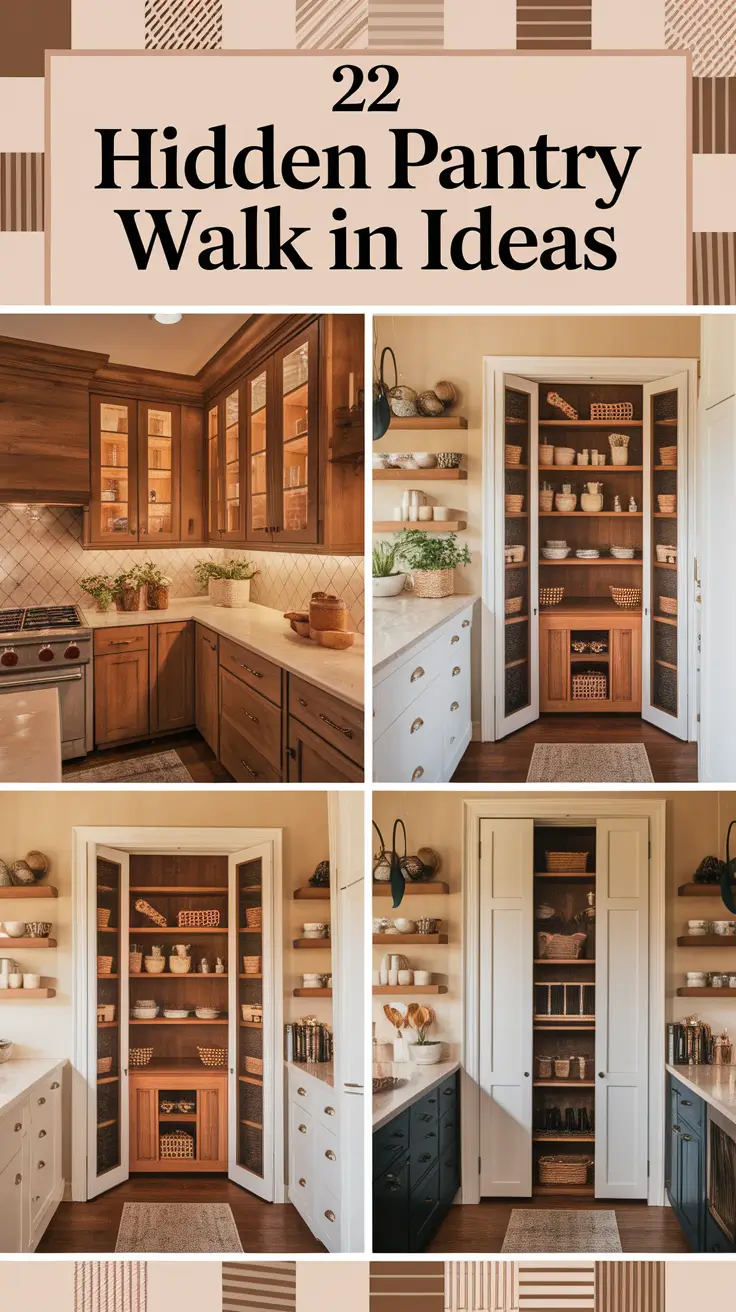22 Hidden Pantry Walk-In Ideas for a Stylish and Functional Kitchen
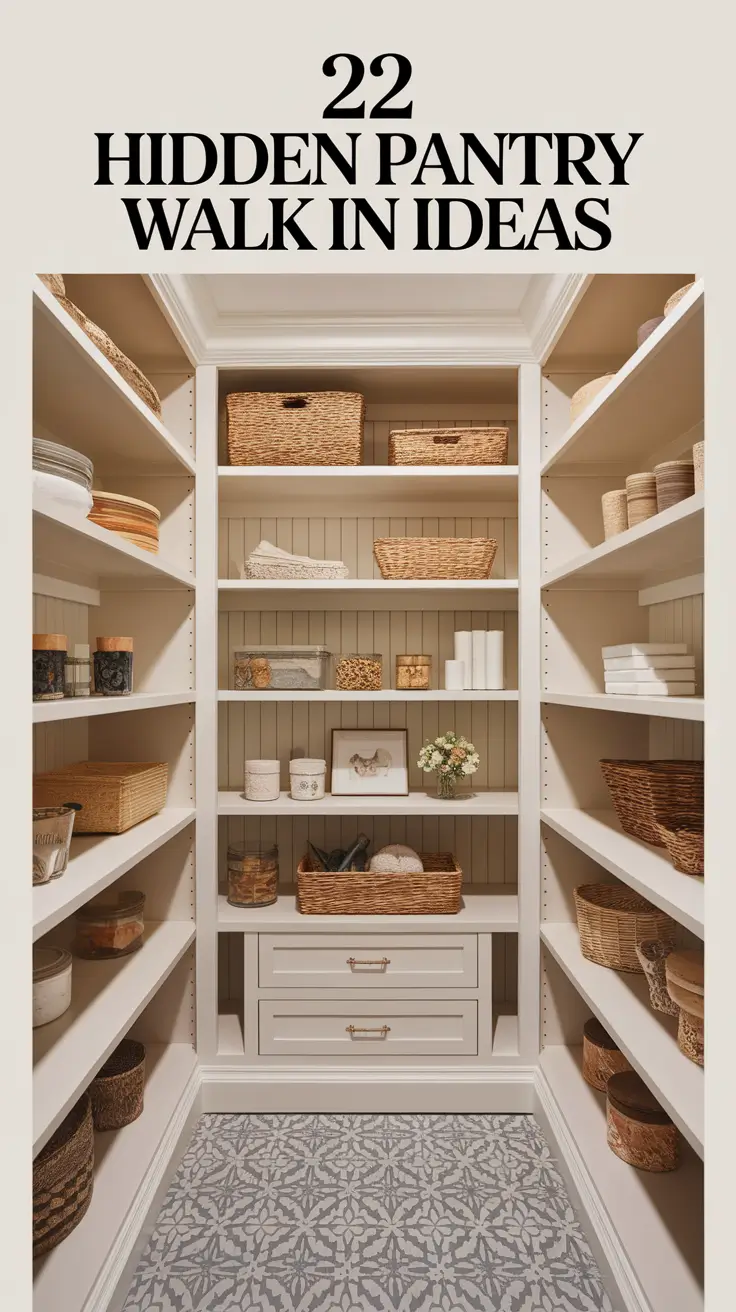
Would you like your kitchen to hide mess and allow you to access your supplies with ease? A hidden walk-in pantry may answer all your storage needs. We’ll look at trendy and practical ways of incorporating a hidden pantry walk in in your kitchen, which will remain sleek and hidden. You will find ideas, good layouts, and professional tips on how to design a walk-in pantry that will fit the most naturally into your home.
Whether your space is small, you want to make your pantry fit in a corner, or you’re renovating your kitchen to have a modern look, these designs show how you can combine practicality and beauty. Find out what makes the effectiveness and style of different hidden pantry walk in designs effective.
Hidden Pantry Walk-In Ideas That Maximize Space And Style
A well-organized hidden pantry walk in provides not only increased kitchen efficiency but also classic visual appeal. In designs I’ve seen, pantry cabinets are designed to flow seamlessly into the kitchen as a whole, hiding clutter from view. Such a design is most beneficial in open-plan kitchens, where unobstructed views and aesthetic unity are of the greatest importance. Unlike conventional pantries, you will have plenty of hidden storage without compromising on a sleek appearance.
My top recommendation is installing shelves from floor to ceiling, built-in drawers and customized cabinets in the pantry. The use of vertical storage makes it possible to maximize small spaces. Popular finishes such as matte white or wood veneer are suitable for the majority of kitchen designs, and sensor-activated lighting installation significantly eases usability. Combining hidden hinges with magnetic push systems helps maintain a clean exterior on the pantry and hides its opening.
Clients who have updated their kitchens with this pantry design often tell me it’s the most used space. Better Homes & Gardens reports that a discreet and efficient pantry can improve the resale value of a home.
To increase functionality, reserving a compartment for small appliances like blenders and coffee makers eliminates clutter on primary working surfaces.

Clever Layouts For A Hidden Pantry Walk-In Kitchen
The floorplan is of critical importance when planning a hidden pantry walk-in for your kitchen. In many cases, I recommend placing the pantry along the back wall of the kitchen or moving it to the adjacent side, depending on the flexibility of the design. A successful approach is to place the pantry behind doors that blend with the entire appearance of the kitchen. Such a design goes well with modern kitchens where sleek lines are necessary.
A good arrangement facilitates free flow of traffic by incorporating open shelving on both sides and leaving enough space for standing in the pantry. The installation of a countertop in the pantry is of great help when preparing meals or placing small appliances. Adjustable shelving and labeling your baskets will help keep pantry items organized, and sliding barn doors or pivot mechanisms fit well into a rustic or modern design style.
From my experience, it is easier for meal prep if the pantry is near the refrigerator or sink. HGTV’s Kitchen Experts emphasize this layout to optimize the efficiency of the kitchen and reduce movement time.
To maximize small spaces, you may want to include a skinny built-in drawer tower or pull-out vertical spice racks.
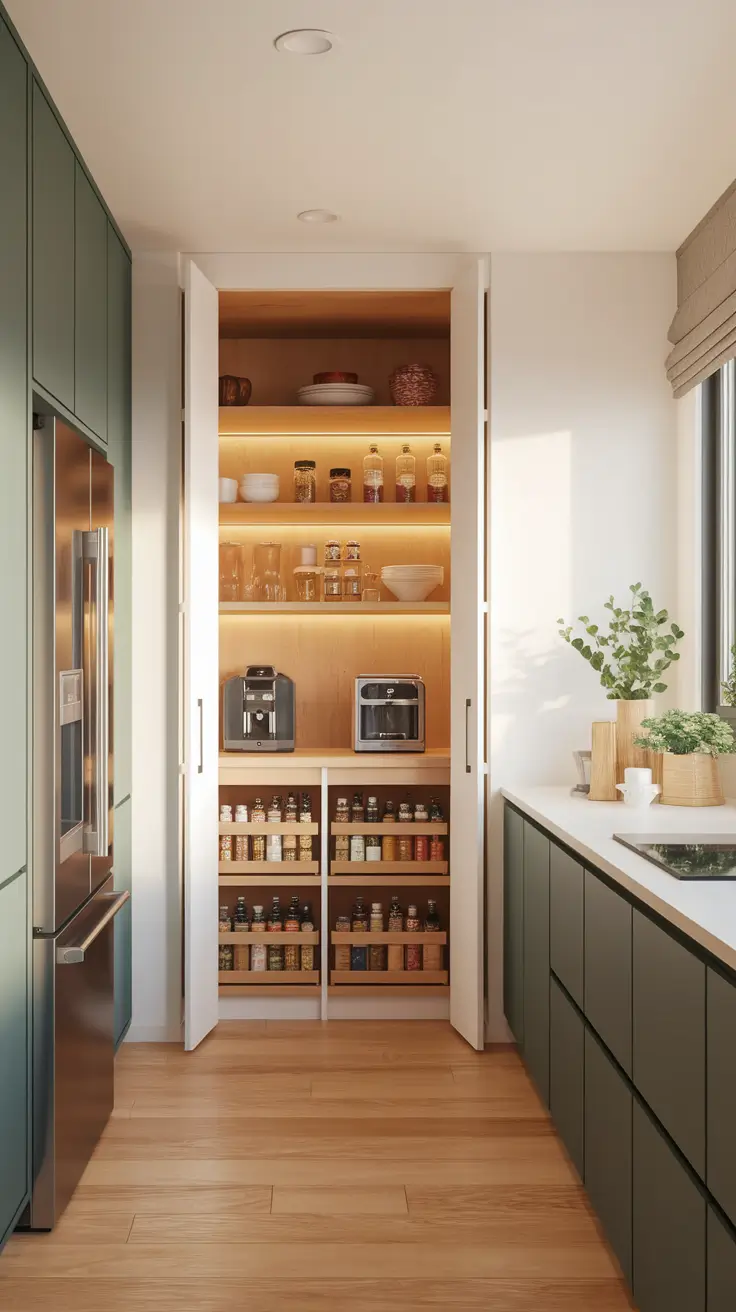
Must-See Hidden Pantry Walk-In Videos For Inspiration
It’s easy to get creative tips for your hidden pantry walk-in with curated videos that show how real households have incorporated these spaces. I love seeing before-and-after walk-throughs that illustrate how seamlessly a pantry can be added without disrupting the kitchen’s visual flow. The hidden pantry walk in videos I have seen many times often feature slow reveals of pantries behind doors, inset panels or even cleverly concealed by mirrors.
In films that I’ve watched, hidden pantries are covered by floor-to-ceiling cabinet doors that conceal all visible hardware. Some pantries hide themselves behind doors that are activated by a mere push, while others use sliding doors to make them attractive and functional. What actually grabs my attention is the large storage that is able to fit in small square footage. Anticipate seeing fashionable LED fixtures, smart appliance garages, and tastefully installed wine rack installations.
I have discovered that such videos are effective in guiding clients who are not sure how the transformation will look. Seeing it in motion builds confidence in the concept. To get a taste of the best real-time high-end designs, Studio McGee and The Kinwoven Home are great references.
I’d add some order to this section with organized video recommendations by size and style, from tiny kitchens to massive open plans, so readers can relate to the examples they see in their own space.
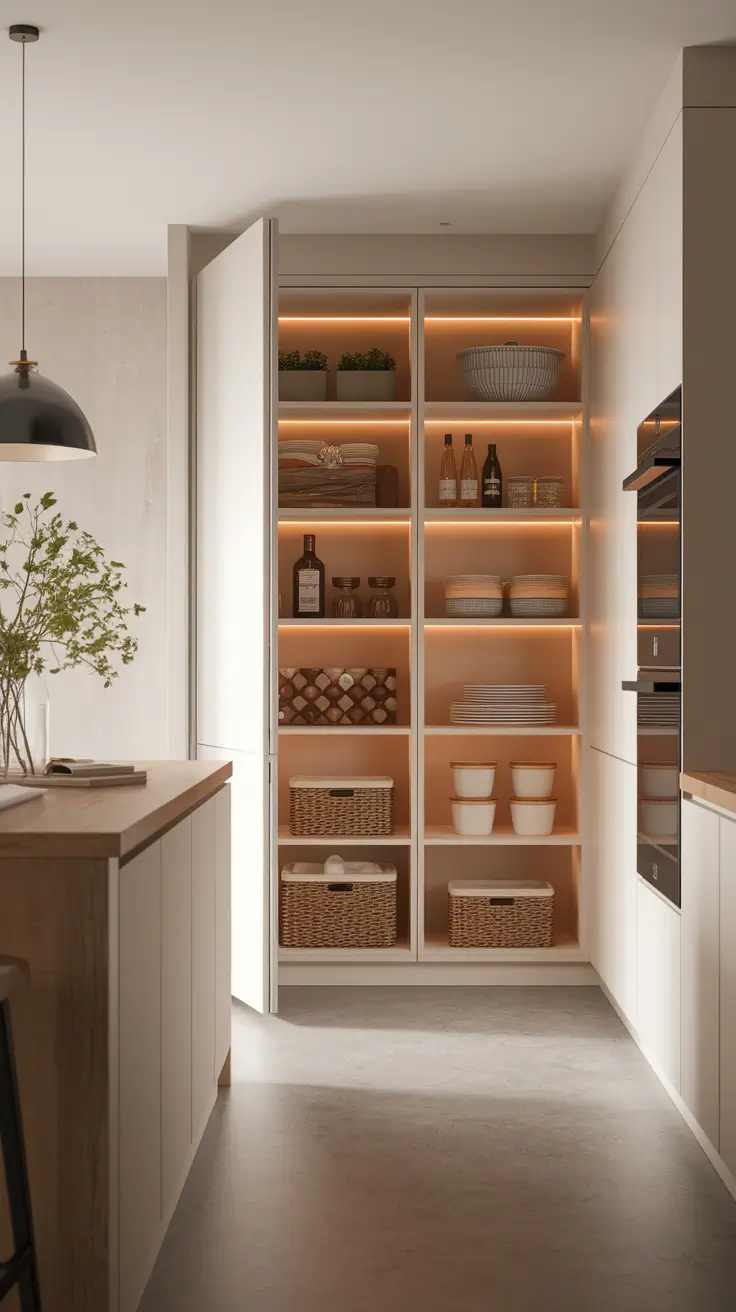
Functional Hidden Pantry Walk-In Floor Plans You’ll Love
Well-designed hidden pantry floor plans combine large storage and easy access. My pantry designs are typically between 25 and 35 square feet, which allows space for shelving, bins, and conveniently, a countertop. Merging the pantry with the kitchen successfully requires preserving the existing architectural flow.
You will usually find that L-shaped or galley-style pantries provide the most efficiency. In these arrangements, I introduce shelves on both walls and provide sufficient room for movement. The addition of a fridge, sink, or microwave to the pantry can provide an extra workspace, which will make the kitchen feel nearly double in size. Don’t forget ventilation—an often-overlooked detail that affects food longevity.
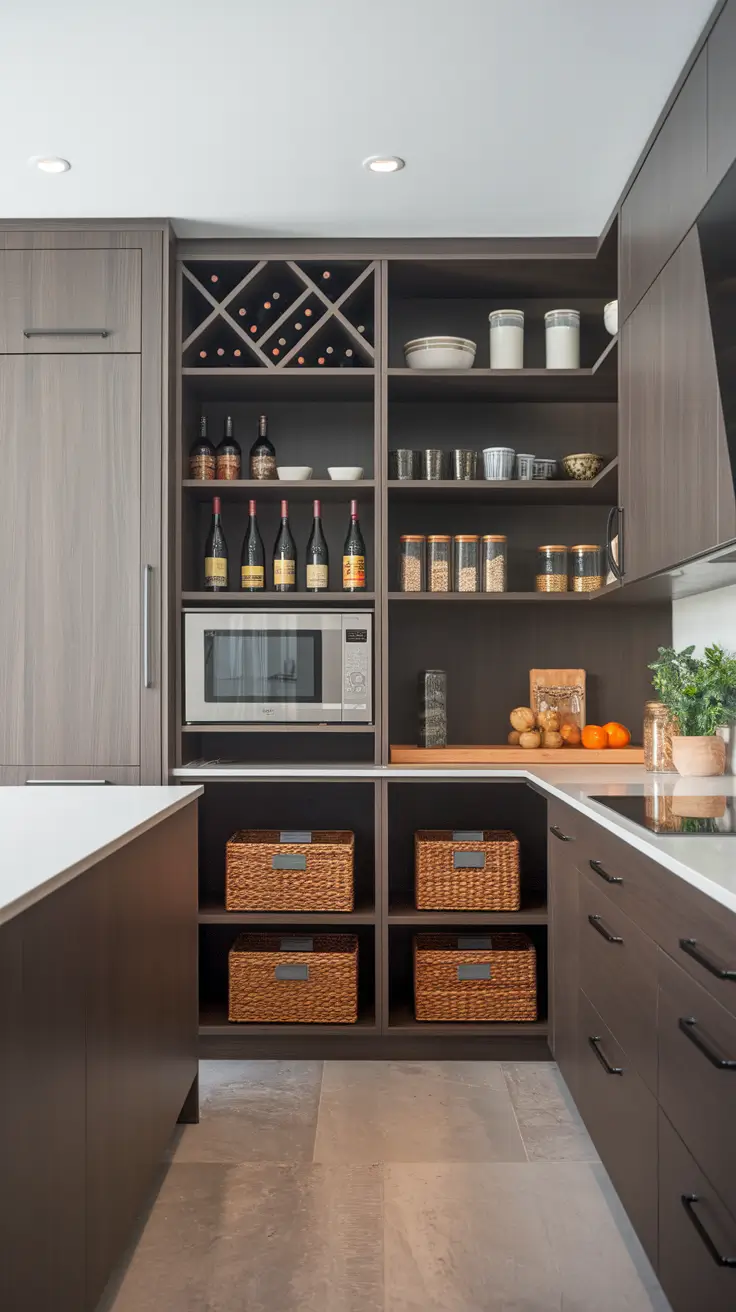
To be honest, I’ve assisted clients in adding skylights or windows to their pantry areas to make the most of natural lighting. According to Architectural Digest, well-lit and ventilated but unobtrusive pantries help to keep efficiency and a clean, high-end appearance.
To enhance convenience, you may use a sliding ladder for storage at the top or a small and mobile island to help move around the pantry.
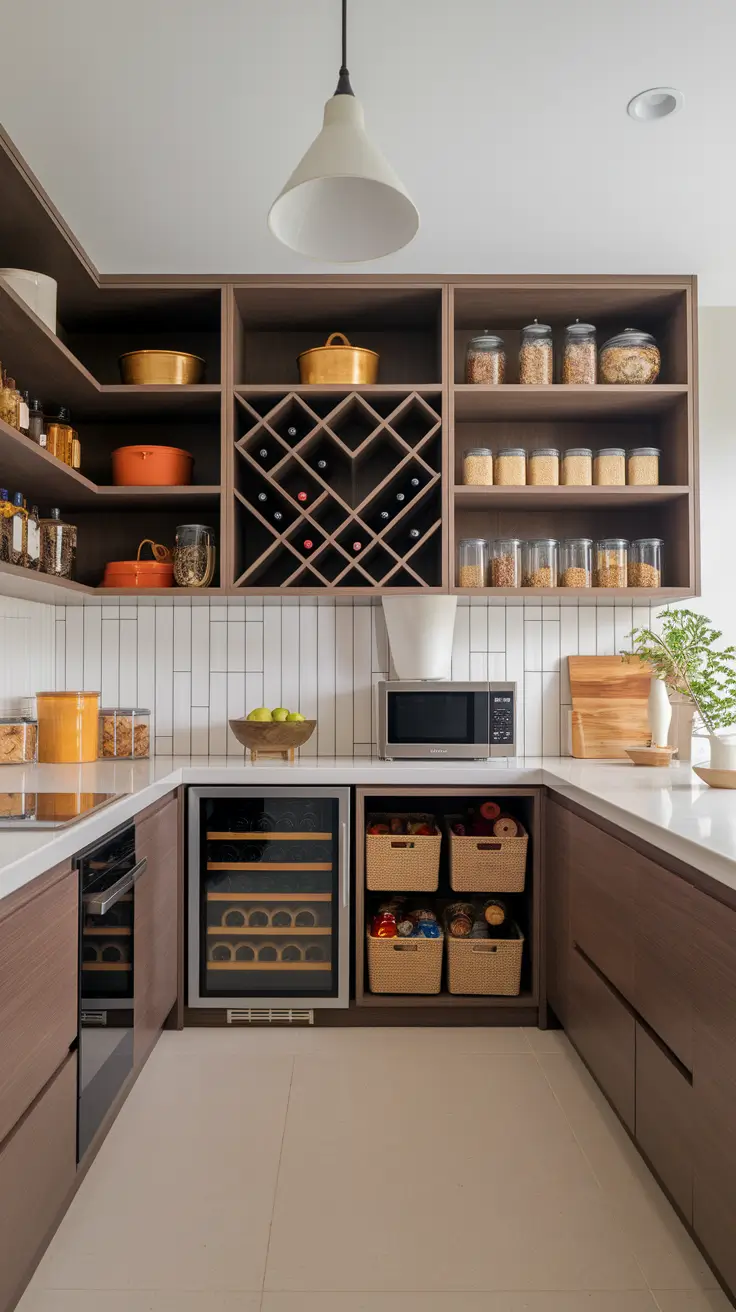
Designing A Hidden Pantry Walk-In Corner For Efficiency
The best strategies to utilize dead corners in a kitchen include the incorporation of a hidden pantry walk-in. My favorite place for the installation of these is in the place where cabinets meet at a 90-degree angle and the pantry can seamlessly fit into the room’s corner. In doing so, the kitchen’s space is preserved yet major storage benefits are realized.
A lazy-susan or wraparound shelving system is usually beneficial for corner pantries. A bi-fold or swing-out style door makes it easy to get to all areas of the pantry. If you want the pantry to visually blend in, mirror or matte paneling is a good option. This design is particularly helpful for small kitchens where every inch is important.
For clients who require storage but do not have space for a standard walk-in, I suggest these options. Elle Decor points out that corner storage solutions are particularly valuable in small or L-shaped spaces.
To make this layout even better, I may add retractable lighting and place a floor to ceiling spice rack or broom closet in the narrowest part of the space.
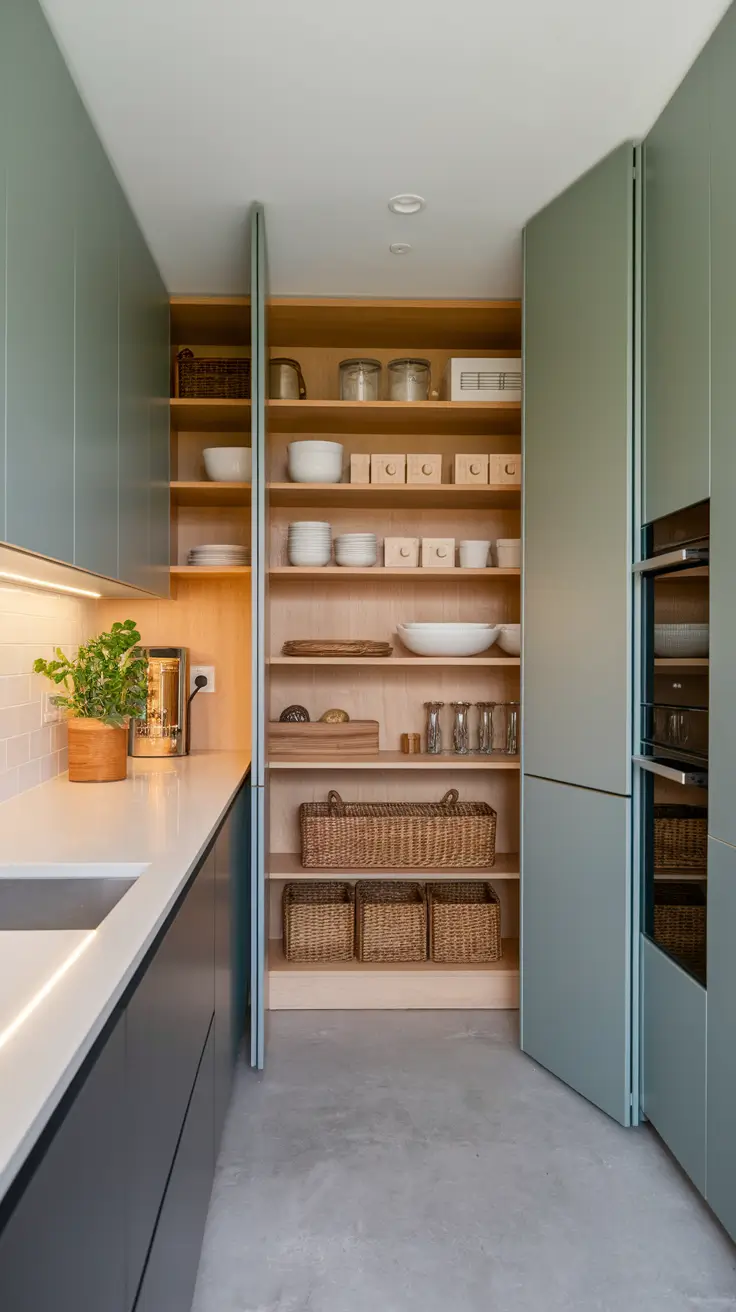
Space-Saving Hidden Pantry Walk-In Layouts Explained
In cramped kitchens, a walk-in pantry should be both thoughtful and unobtrusive. I’ve found that narrow galley-style arrangements, carefully hidden behind sliding doors or deep cabinet panels, often do very well. Using vertical organization assists – by placing in adjustable shelving units, tall drawers, and modular bins.
Practical arrangements usually include cabinets on top for dry storage, middle drawers for jars and cans, and baskets below shelves for snacks. I usually add a pegboard or open rail system on one wall to hang things. These design features avoid messiness and make use of every inch of space.
To me, these designs address storage problems in small kitchens where normal cabinetry is insufficient. The Spruce notes that this feature is in vogue for newest townhomes opting for cleaner, space-saving interiors.
A little something extra is including a built in charging station or tablet dock so you can easily look up recipes while working in the pantry.
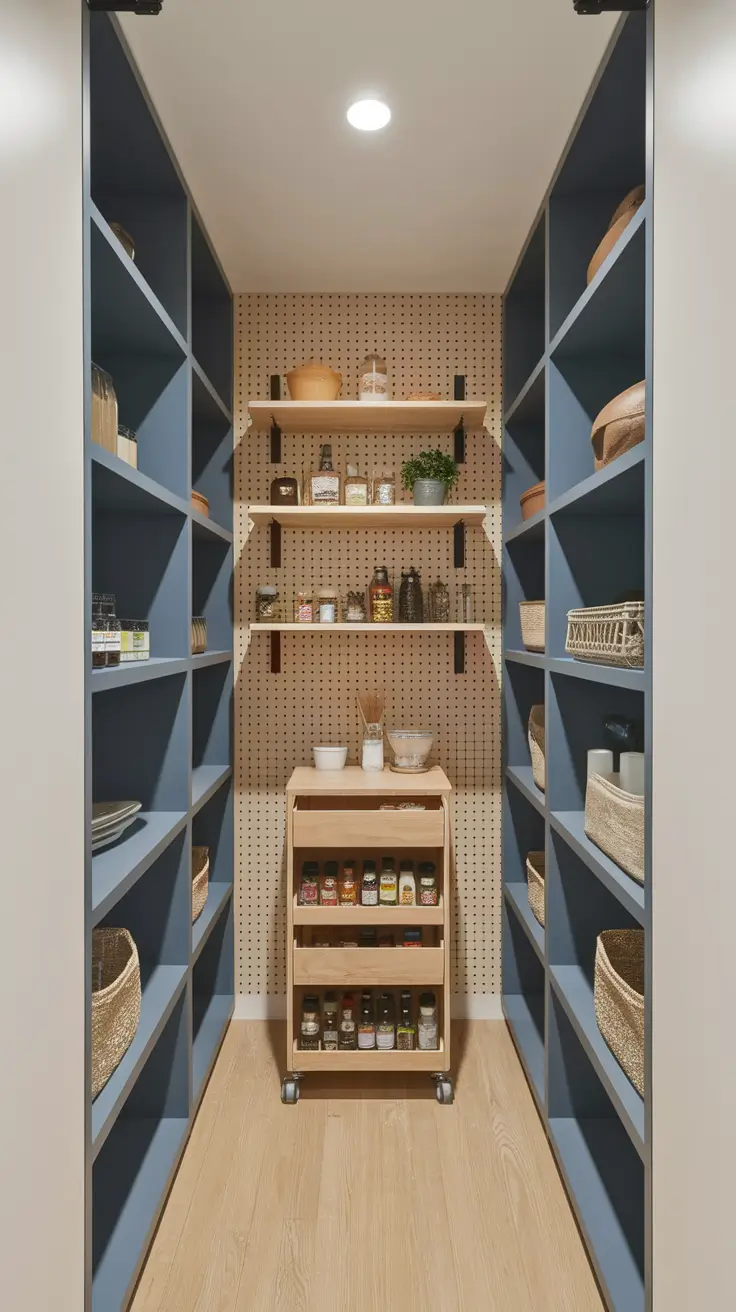
Stunning Hidden Pantry Walk-In Design Inspiration
For ideas on style, the hidden pantry walk-in design usually follows trends in high-end European kitchens. Opulent pantries are usually hidden behind beautiful wall panels, old mirrors, or sleek modern cabinetry. From the outside, it looks like sophisticated interior design, but the inside provides practical preparation or storage capabilities.
One of the best examples had brass finished shelves, with marble surfaces and concealed lighting to create a warm glow. Adding glass-front drawers or labeling wooden bins organized the space. Wallpaper or stone-textured backsplash completion assists in achieving a touch of high interior decor, similar to the main kitchen.
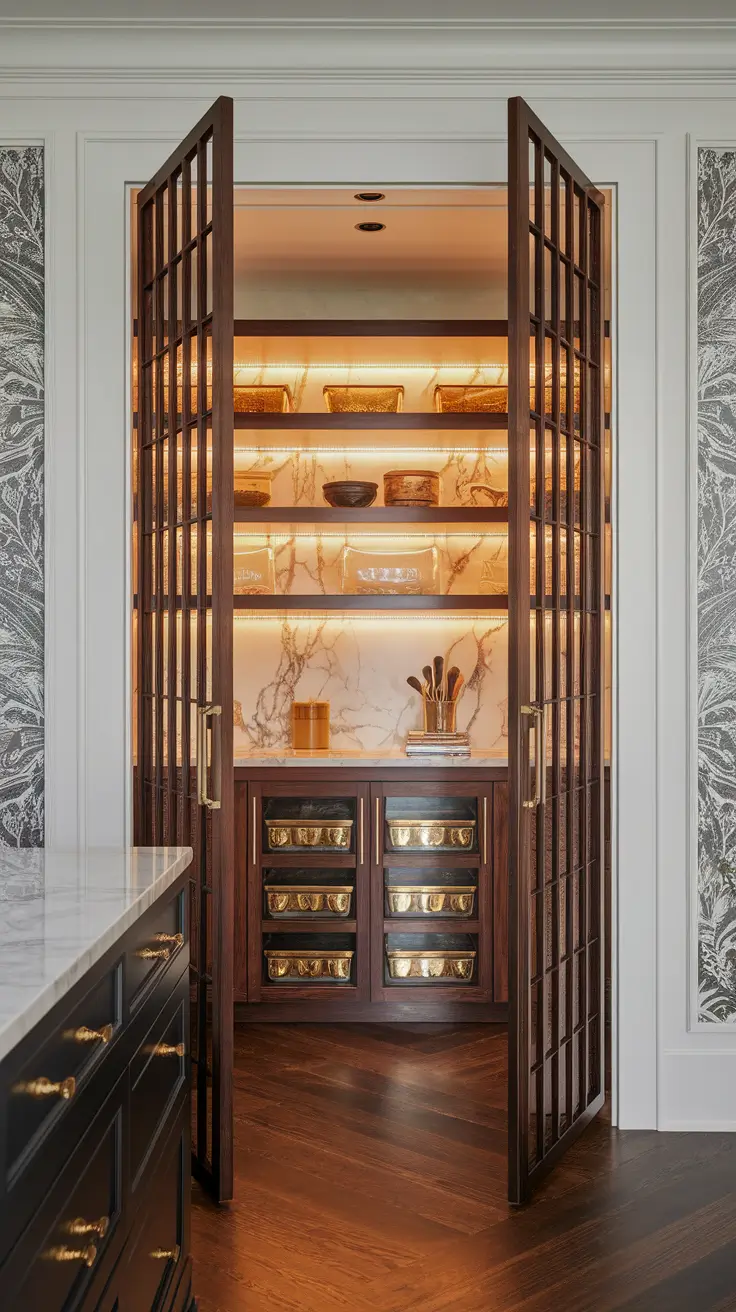
In my opinion, such designs are best for clients who view their pantry as a natural part of their home, as opposed to just a storage room. Walk-ins that are similar to exclusive food store settings are regularly featured in Veranda Magazine.
Floral or wood-decorated elements can be used to increase a modern pantry’s appearance softness and originality.
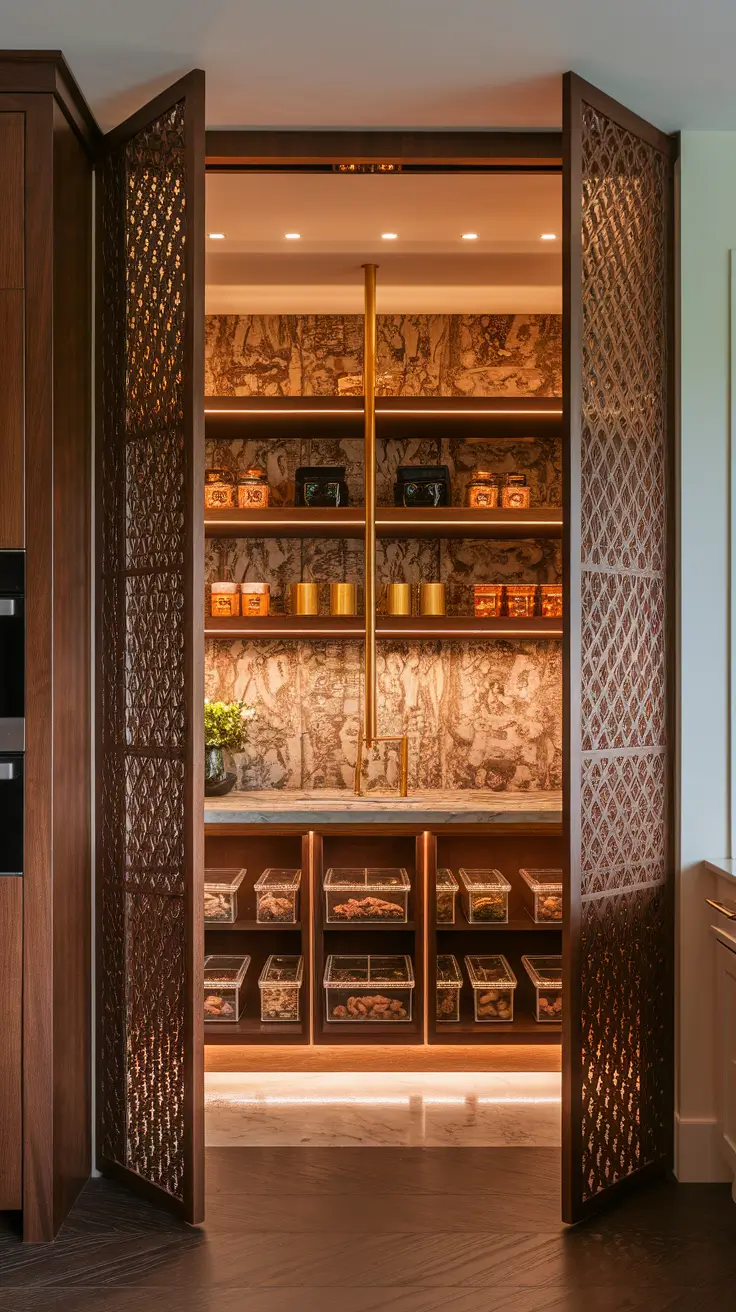
Choosing The Perfect Hidden Pantry Walk-In Door
The concealed pantry entrance is critical to the practical use and beautiful kitchen design. I impress upon clients that the door is a critical element in maintaining or breaking the illusion of a seamless kitchen. A cabinet door flush with the surrounding panels is ideal in my opinion for contemporary aesthetics. In transitional homes, you can bring character to the space while hiding the pantry by using pocket or barn-style doors.
My material preference is for slab doors with subtle hinges or effortless slide mechanisms. Basic push-to-open or magnetic latches keep the surface clear and easy to use. In some of the designs, I’ve incorporated automated soft-close doors, which add to the space and protect the cabinets in the long run. Your door finish should match the style of your kitchen, whether matte, gloss or woodgrain, to integrate well.
I believe the choice of a door is frequently neglected in designing a hidden pantry walk-in. Southern Living has noted that “With the ideal concealed door, a pantry can be a secret pleasure”. It’s true—when executed correctly, the door adds mystery and elegance to your kitchen layout.
I’d suggest adding soundproof doors if your pantry doubles up as a prep area with appliances such as dishwashers or blenders.
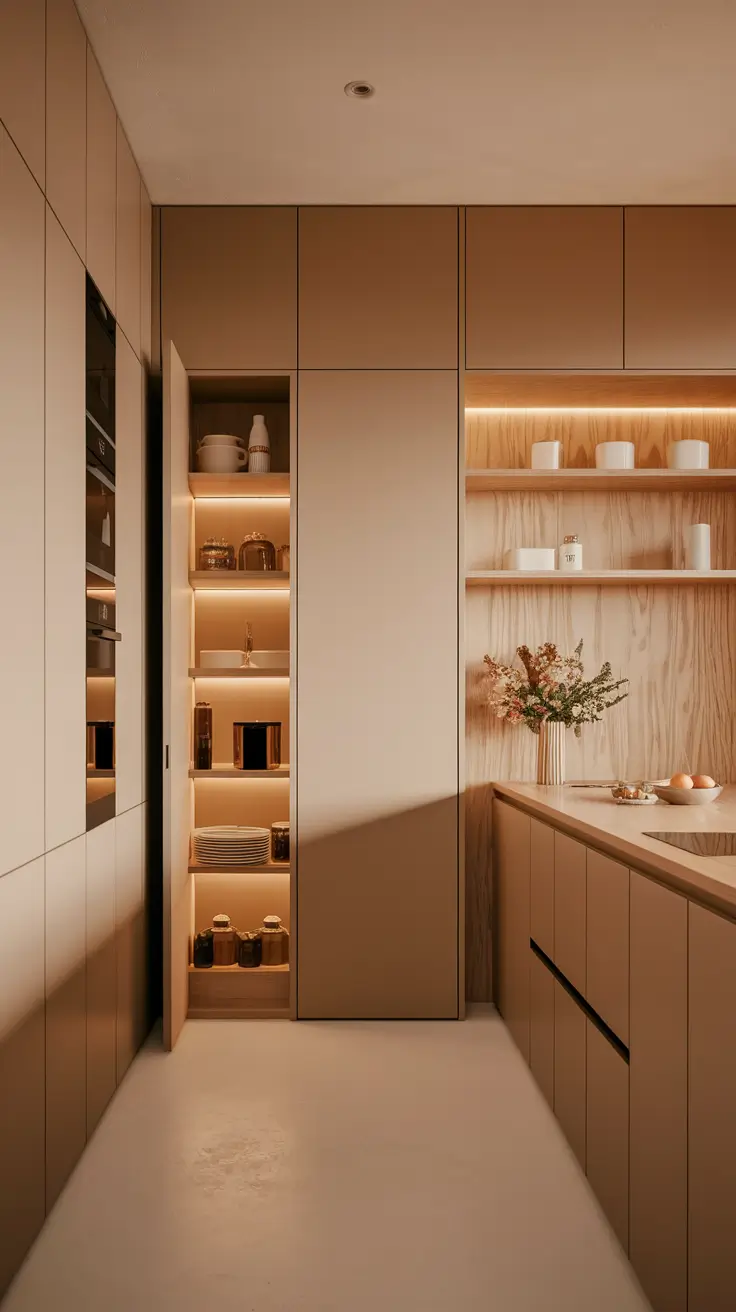
Sleek Hidden Pantry Walk-In Kitchens For Modern Homes
In the design of modern, hidden pantry walk in kitchens, minimalism is critical. I generally use handleless cabinetry, built-in appliances, and a neutral color scheme to keep the same design throughout the room. By incorporating the pantry behind cabinets of the same height as surrounding wall units, it is hidden from view, unless one knows where to look.
The interior of these pantries is just as refined: The pantry gains graceful looks through a combination of open walnut shelving, brushed brass lighting fixtures, and stone slab countertops not overpowering the surroundings. When necessary, I incorporate an internal sink or a small refrigerator to increase the pantry’s functionality. In order to create continuity, the flooring should blend with the kitchen as a whole – either hardwood or polished concrete will work well with this design approach.
These pantries have become popular in the city living spaces and households that appreciate design. These pantries are frequently seen in Dwell’s articles on Scandinavian and Japandi interiors that focus on uncluttered and structured design.
Integration of smart home amenities such as motion sensor lighting, or voice controlled entries, contributes to a perfect balance between the use of technology and minimalist design.
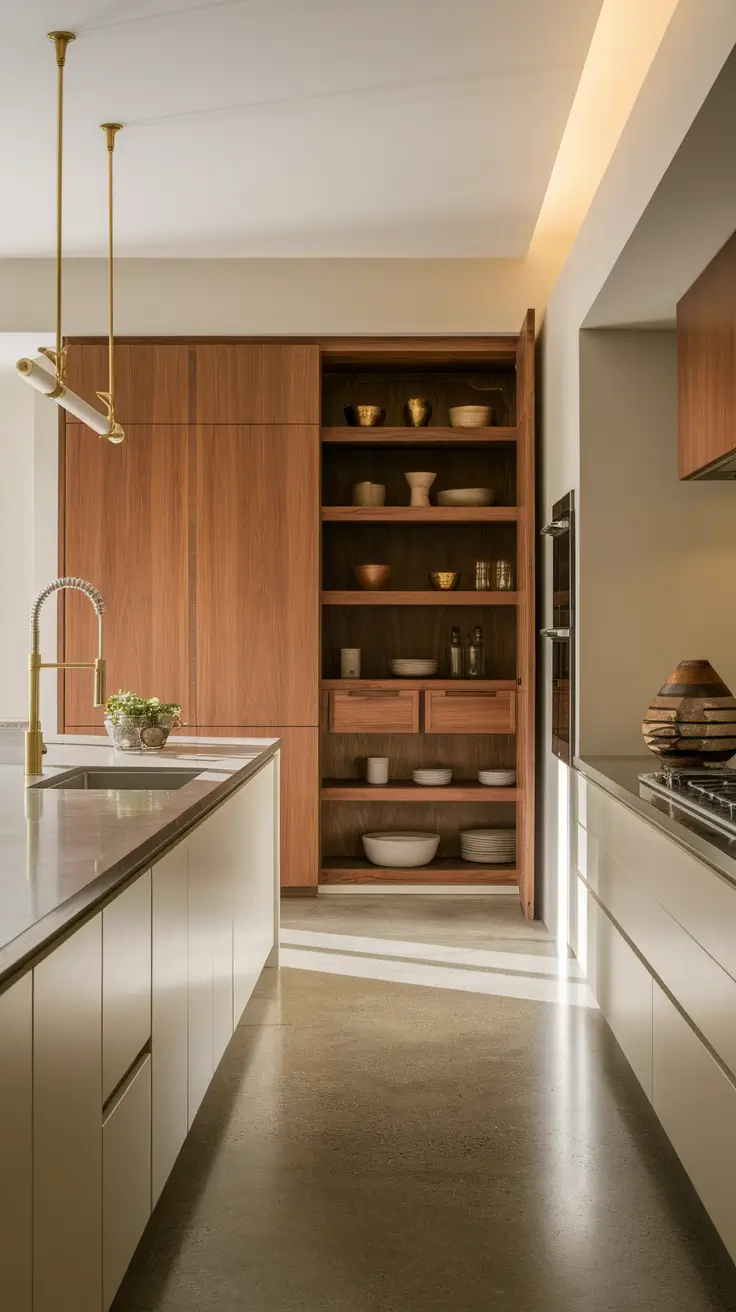
Smart Hidden Pantry Walk-In Solutions For Small Kitchens
When designing a hidden pantry into a small kitchen space, creative design ideas are necessary. Even in small space, a 2-foot-deep pantry can still be very practical. It is not unusual for me to recommend to clients to place the pantry behind a single full-sized cabinet panel next to the refrigerator or oven. If you think vertically and add stackable shelving, you can make the most of storage in a small area.
Within, I like adjustable metal shelving, hanging door accessories and extending wire baskets. The lightness of such materials guarantees the kitchen is visually airy. The door could be a bifold or single swing door that folds neatly into the wall when closed. To save even more space, I incorporate the pantry behind a neighboring wall or in a hallway wherever possible.
My advice to clients usually involves the concept that small kitchens don’t lack storage possibilities, but require smart approaches to placement and use. Apartment Therapy had a case study showing that a 10 square foot pantry increased the efficiency of a kitchen due to clever design.
Think about installing a slimmest built-in spice rack or a retractable storage tower that can be pulled out between appliances.
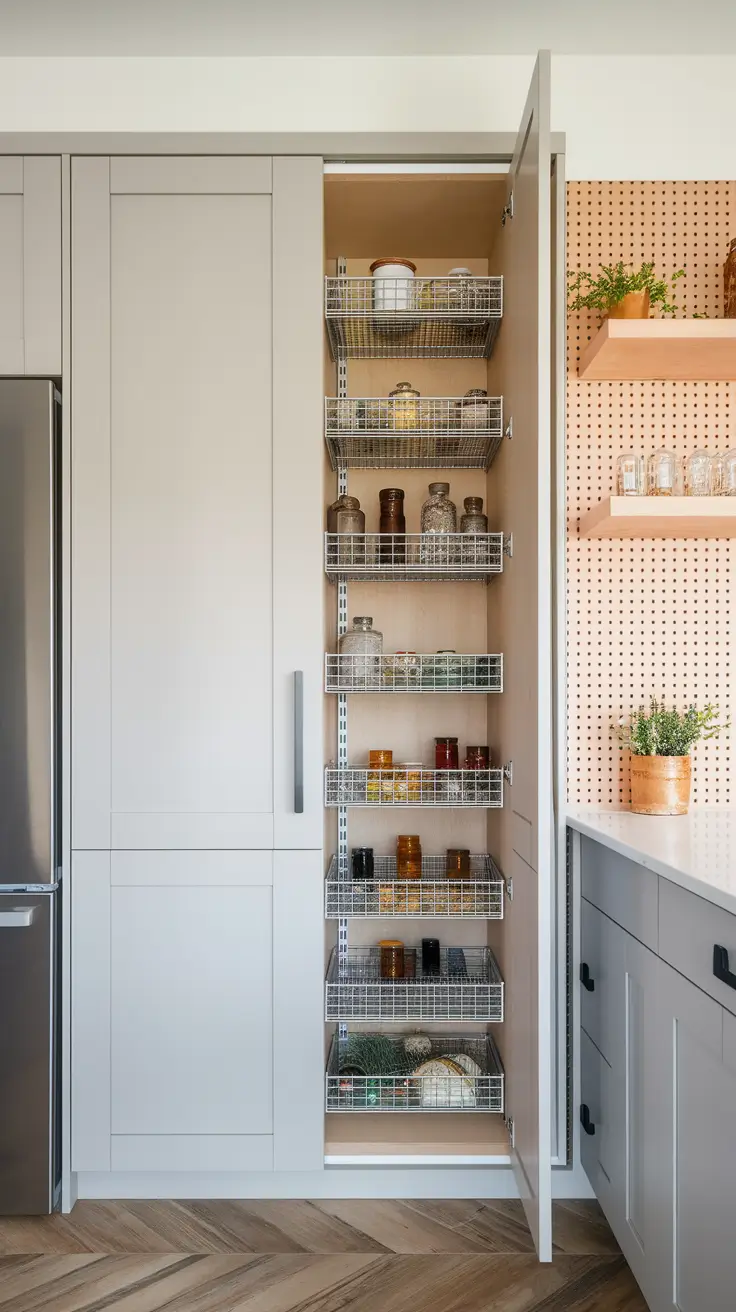
Elegant Hidden Pantry Walk-In Ideas With Glass Doors
Integrating glass doors in an invisible pantry gives an open feeling while maintaining contents in secret. Because glass doesn’t block light, it can brighten enclosed or darker areas of the kitchen significantly. Reeded or frosted glass provides the pantry with a soft reveal, so the contents aren’t the center of attention.
The surrounding cabinetry usually frames the glass panel, and it’s often accompanied by aluminum or black steel for an industrial-modern look. Avoiding visual clutter, use amber jars, woven baskets and ceramic crocks to decorate the interior of the pantry. Soft lighting from ambient lighting under the shelving is created in the pantry when opened at night.
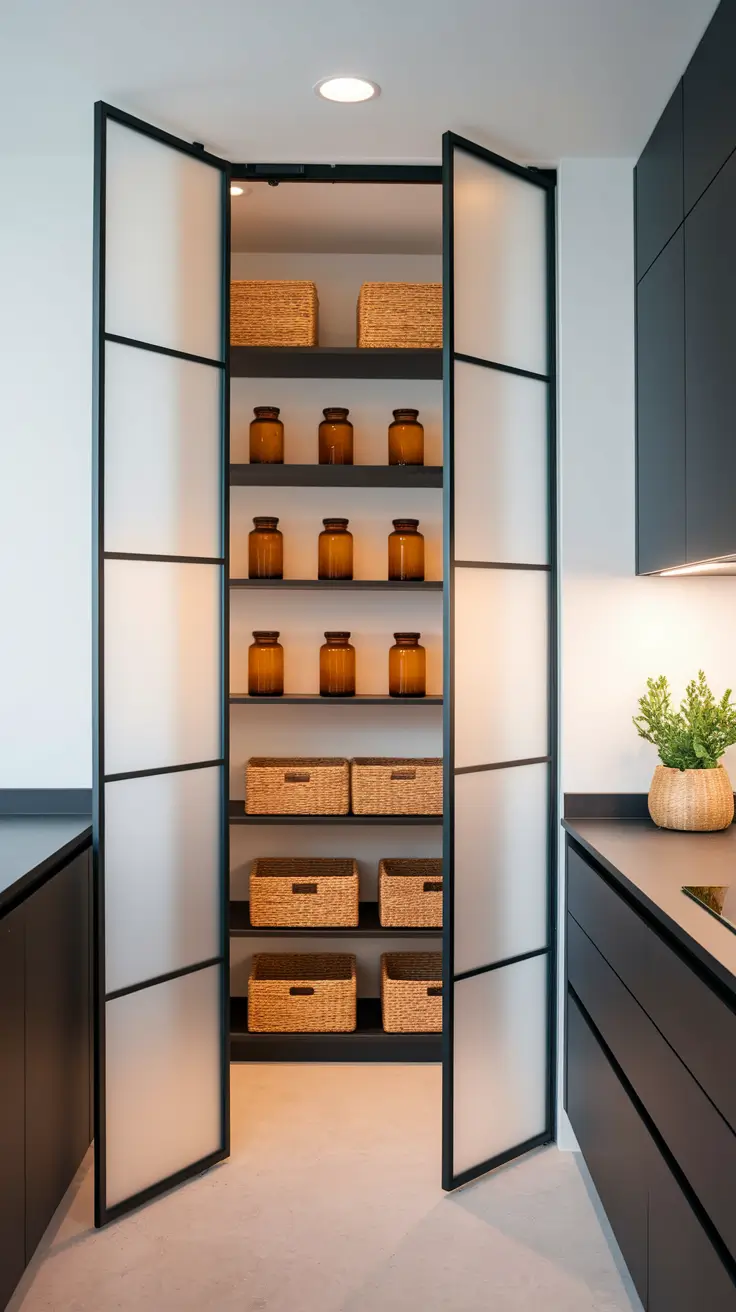
Glass door pantries are becoming more popular because they are elegant and practical. House Beautiful has covered this style in kitchens that have a “hotel-chic” look with functional purpose.
The addition of soft-close hardware in combination with a sliding mechanism can make the glass door a smooth and noiseless one.
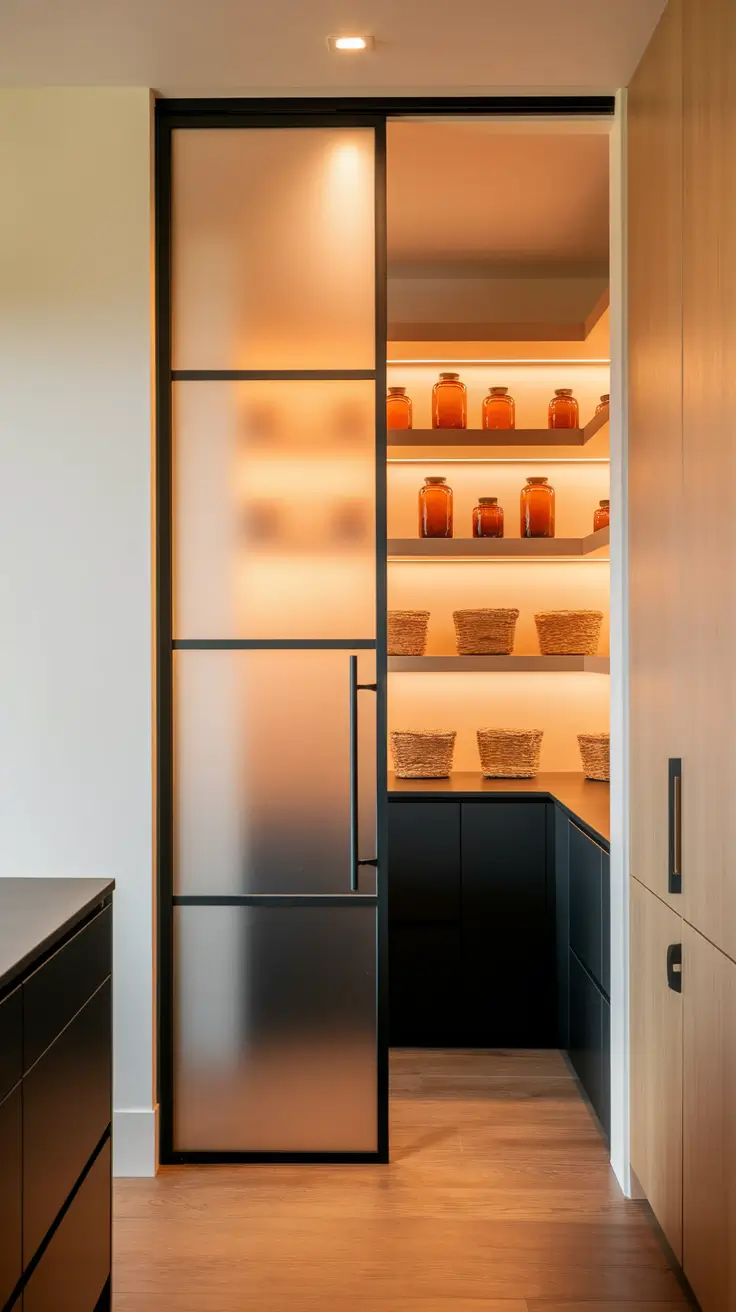
Standard Hidden Pantry Walk-In Dimensions To Know
In order to make the pantry design work effectively, you must be well aware of its dimensions. I recommend that people leave at least 3 feet of walkable space in the pantry and shelves 12–15 inches deep on each side. By offering this width, it facilitates easy passage, deeper shelving and a safe means of movement for people. For galley-style pantries, such an arrangement can fit in a five-foot-wide space.
Shelves should be organized leaving a minimum of 10–12 inches between each of them to accommodate cereal boxes, baskets and small appliances. In my designs, there is usually one or two taller zones reserved for storing paper towels, small vacuums, or containers for pet food. Good design promotes the placement of heavier items at the bottom tier and storing frequently used items at eye level.
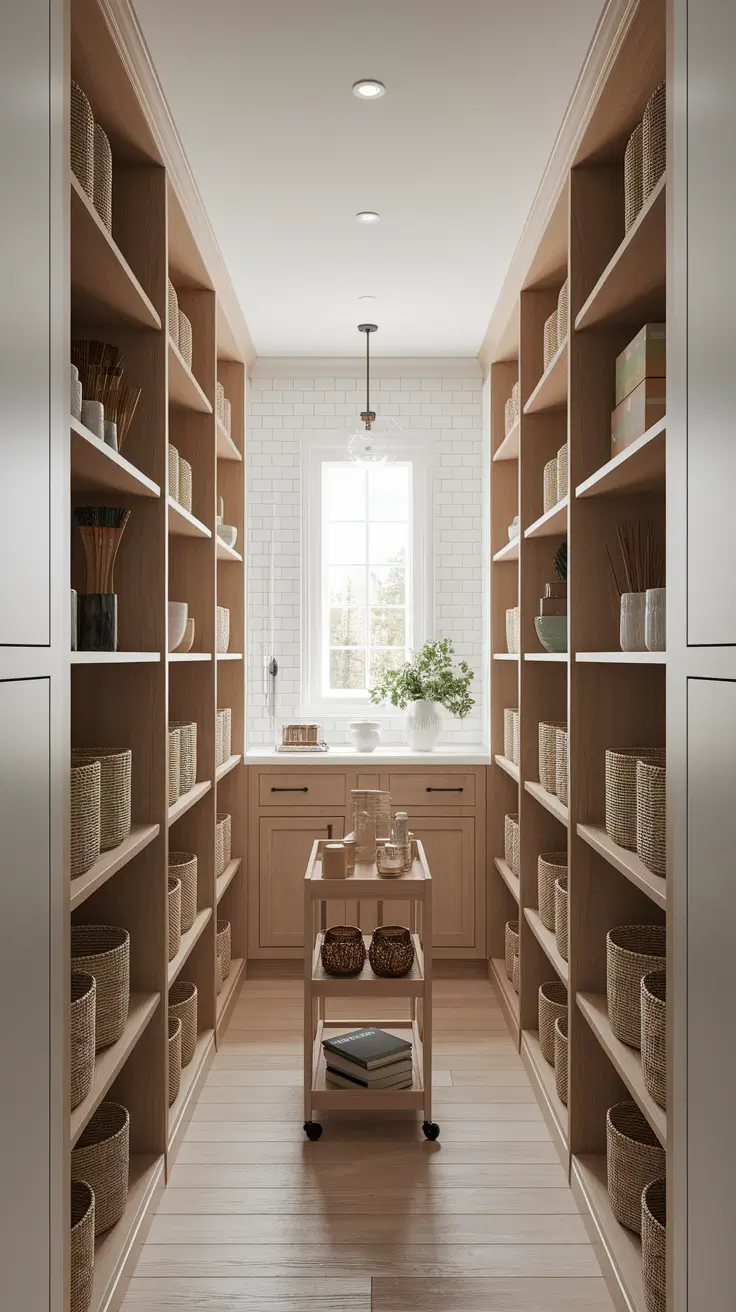
Based on what I’ve seen, a lot of homeowners often forget how much storage space they need. This Old House reports that pantry storage needs should be based on weekly food purchases and appliance size, and I make sure that clients are aware of this advice.
The inclusion of a measurement template and flexible shelving in this area can improve its adaptability and usefulness in future.
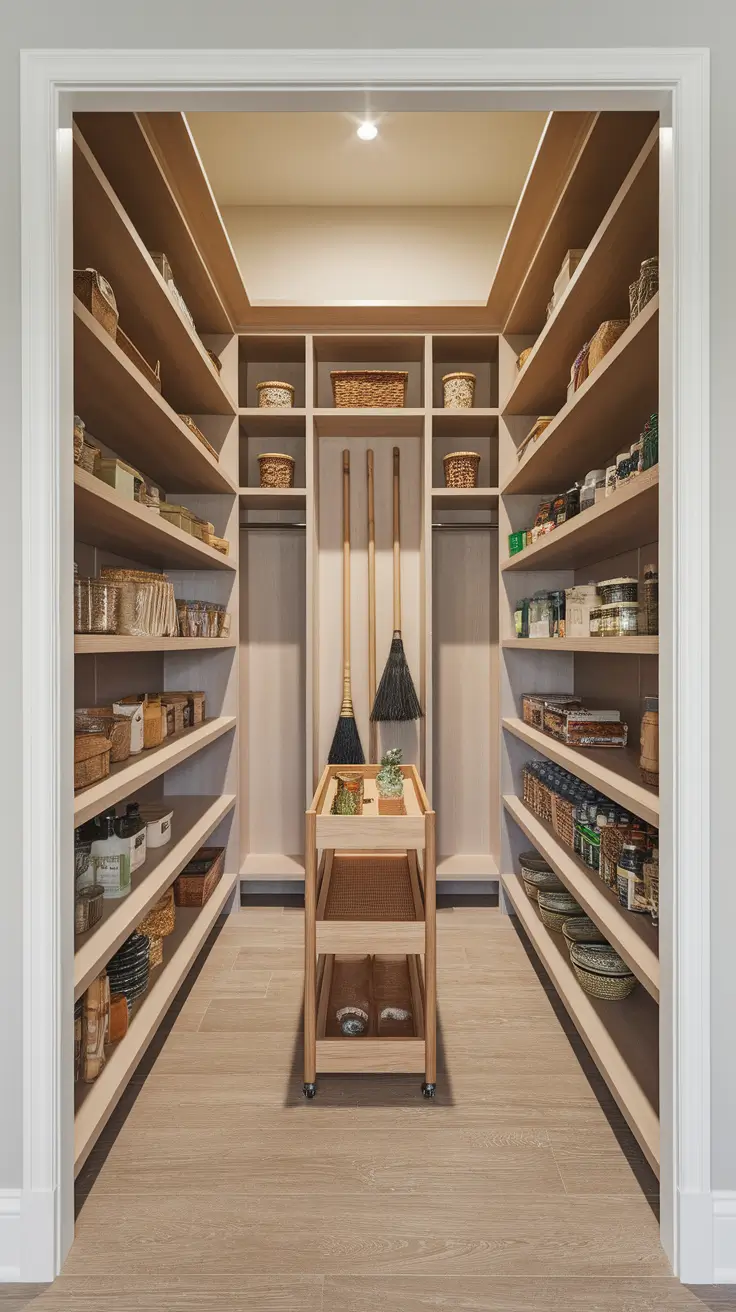
Why Every Modern Kitchen Needs A Hidden Walk-In Pantry
Adding a hidden pantry walk in is no longer a luxury idea—it’s a smart upgrade that enhances everyday life and adds value to the home. In modern kitchens with their focus on open spaces and smooth finishes, hiding the functional areas of the pantry preserves the overall look and eases daily life. I’ve seen countless clients reduce countertop clutter just by relocating items into a walk-in pantry.
The practicality is unmatched: You have room for oversized purchases, electrical devices, seasonal serving pieces, and even convert it into a quick prep area. You can store bulk items, appliances, seasonal dishware, and even use it as a prep station. When a sink or refrigerator is installed, its function increases, and the pantry becomes an auxiliary kitchen space. A coffee maker or microwave hidden in the pantry is a convenient means of keeping clutter off kitchen countertops.
To my mind, the popularity of concealed pantries indicates a trend in the industry towards designs that focus on everyday comfort. Architectural Digest mentions that a concealed pantry works for your kitchen just like a walk-in closet does, so everything looks more organized and purposeful.
To make this design even better, I’d recommend sound-reducing panels as well as flexible shelving that can change with your life.
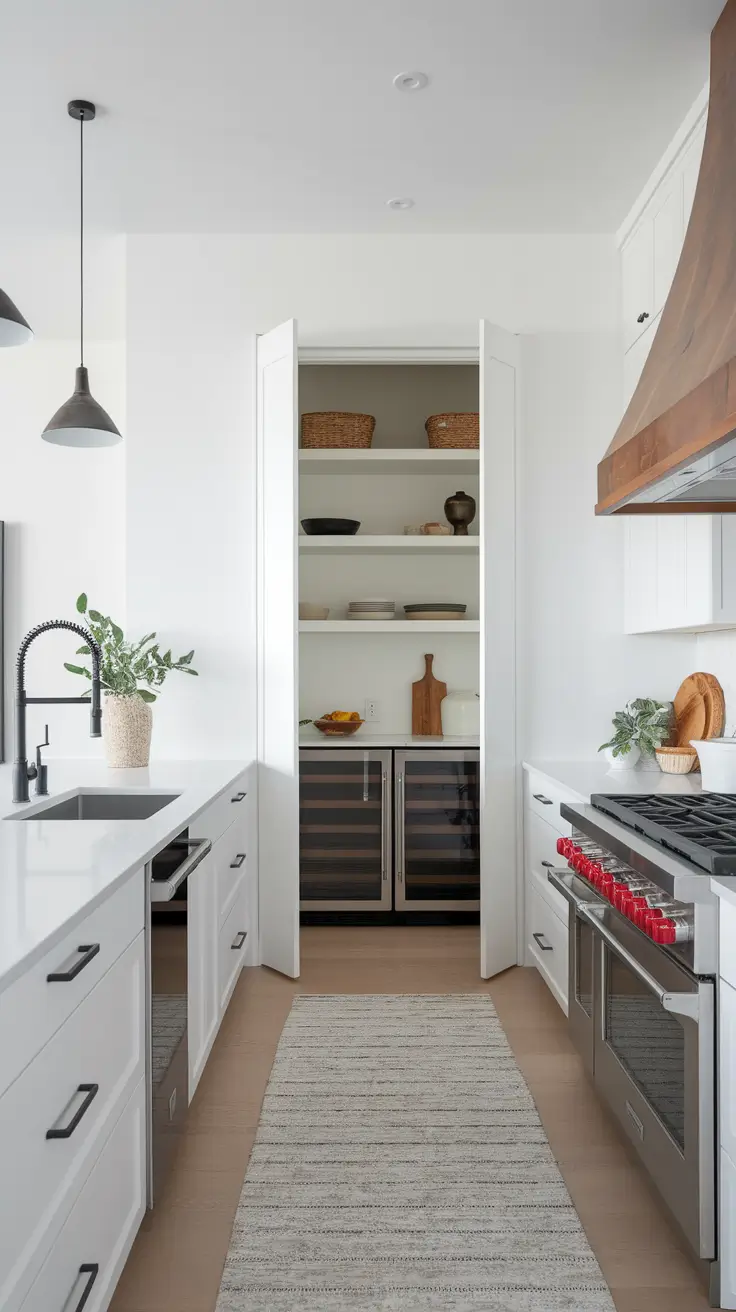
Integrating A Sink Into Your Hidden Pantry Walk-In
Adding a sink to your hidden pantry walk in makes it a very functional area. The presence of a sink in this area makes it much easier to wash vegetables, prepare food or clean up messes without dominating the main kitchen. If your home experiences a lot of cooking or entertaining, I highly recommend installing a prep sink if the space and plumbing allow.
My usual solution is to incorporate a petite under-mount sink, stainless steel, or a farmhouse sink, both fitted with a simple, classic faucet. You will prefer the countertop around the sink to be waterproof, and quartz and sealed butcher block are good choices. It is also possible to increase the practicality of the pantry by adding a pull-out trash bin and towel rack nearby. Dusk-to-dawn task lighting above the sink is essential for those who begin or end their cooking days in dim light.
After installing hidden pantry sinks in at least a dozen kitchens myself, the reaction I receive each time is, “I can’t believe I didn’t think of this before!” The Kitchn recommends that you add a prep sink to your pantry whenever it serves as a prep or dish zone.
To enhance this section, I’d consider including a water filtration system or even a mini dishwasher for serious cooks or large households.
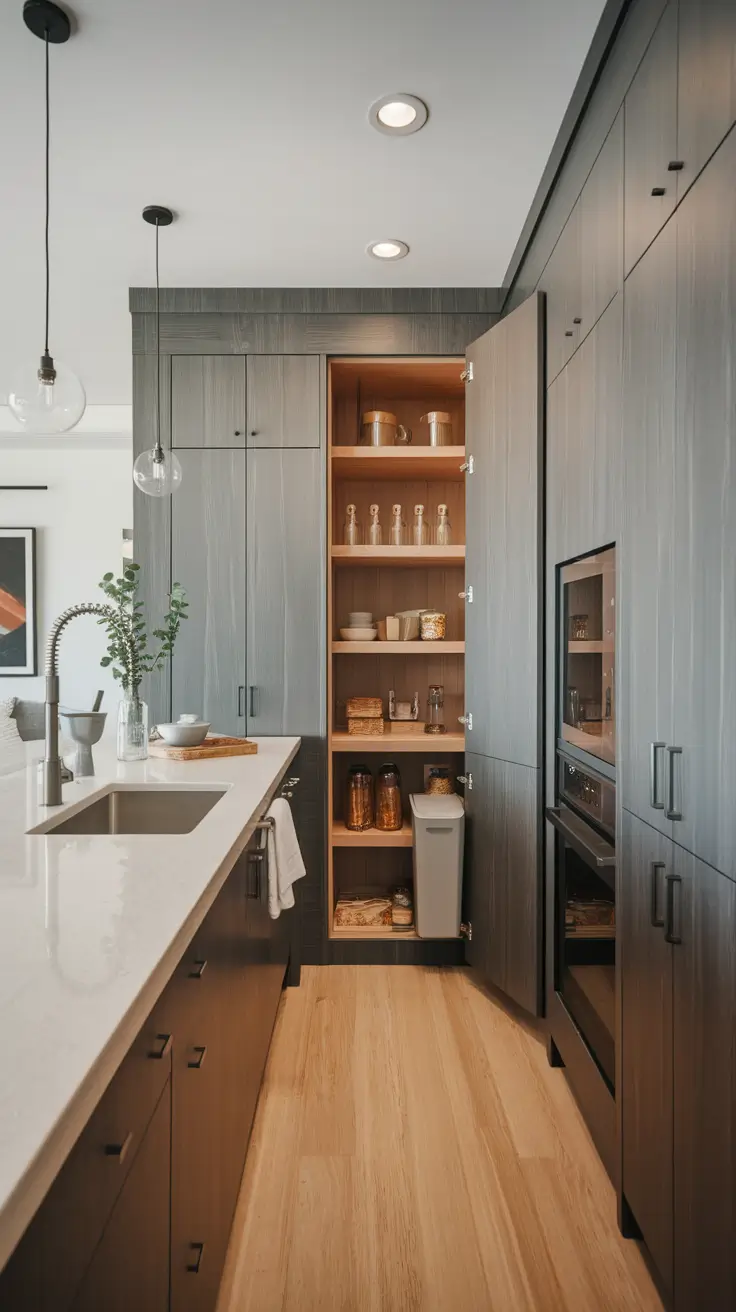
Hidden Pantry Walk-In Ideas That Include A Fridge
When you add a fridge to your hidden pantry walk in, it adds a lot to the appearance and function of your space. This arrangement is of great help to the modern style, which stores away large appliances but leaves them accessible. In my observations, these designs are the stars of contemporary kitchens where clean and well-designed cabinetry hides the entrance to walk-in pantries that combine food storage and refrigeration units. It permits a neat appearance without compromising all functions’ full operation.
My recommendation is to choose a counter-depth fridge that will perfectly fit into the cabinets. Add generous pantry storage, a lightweight rolling ladder, and flexible bins to the design. Organize your food items in the pantry by groups and by temperature preference. Add a touch of sophistication and seamless integration with soft lighting, matte black hardware and ventilation that is hidden. A centrally located prep station increases efficiency and keeps traffic open.
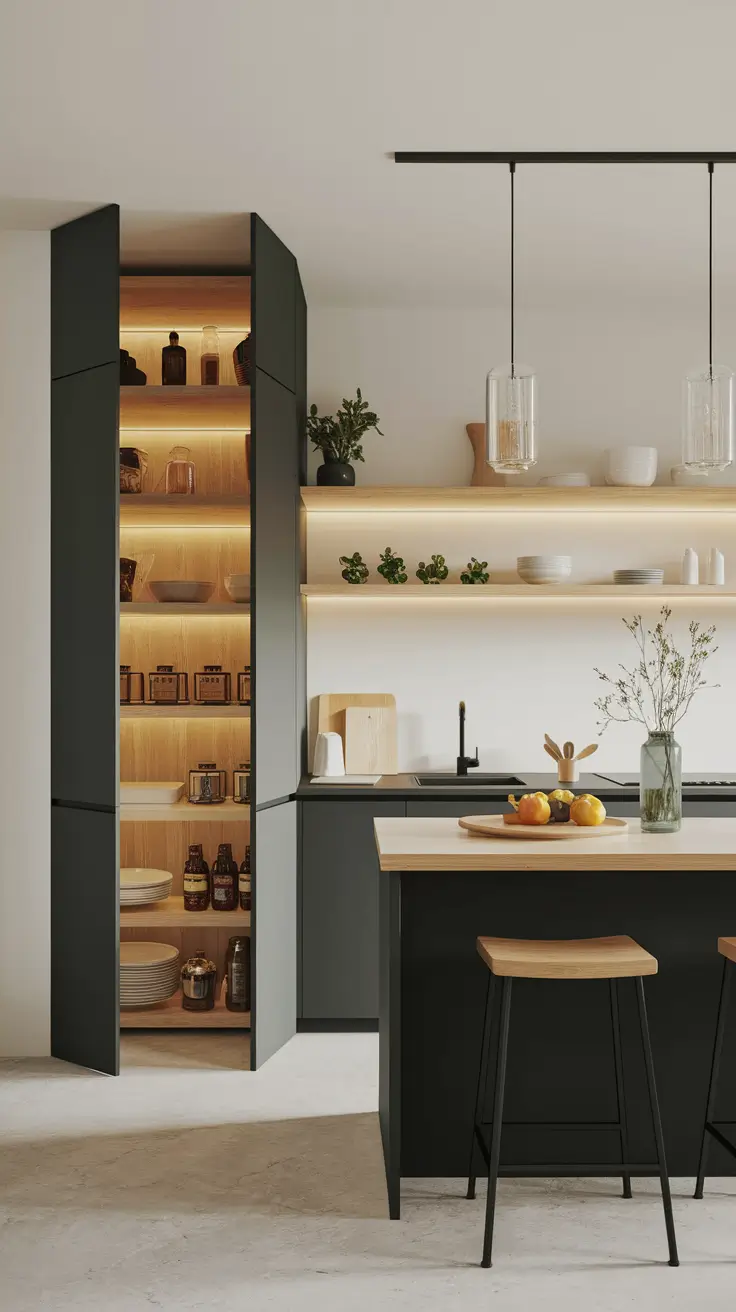
I find that this design is attractive to many clients because it provides plenty of room in the main kitchen area. As Architectural Digest shows, this approach helps to keep a streamlined look in open kitchen design. While working with a client in Austin, I discovered that they felt significantly less visual tension once the fridge was hidden.
I would upgrade this part by suggesting mini-freezer units and a filtered water dispenser in the pantry, and self provided food storage.
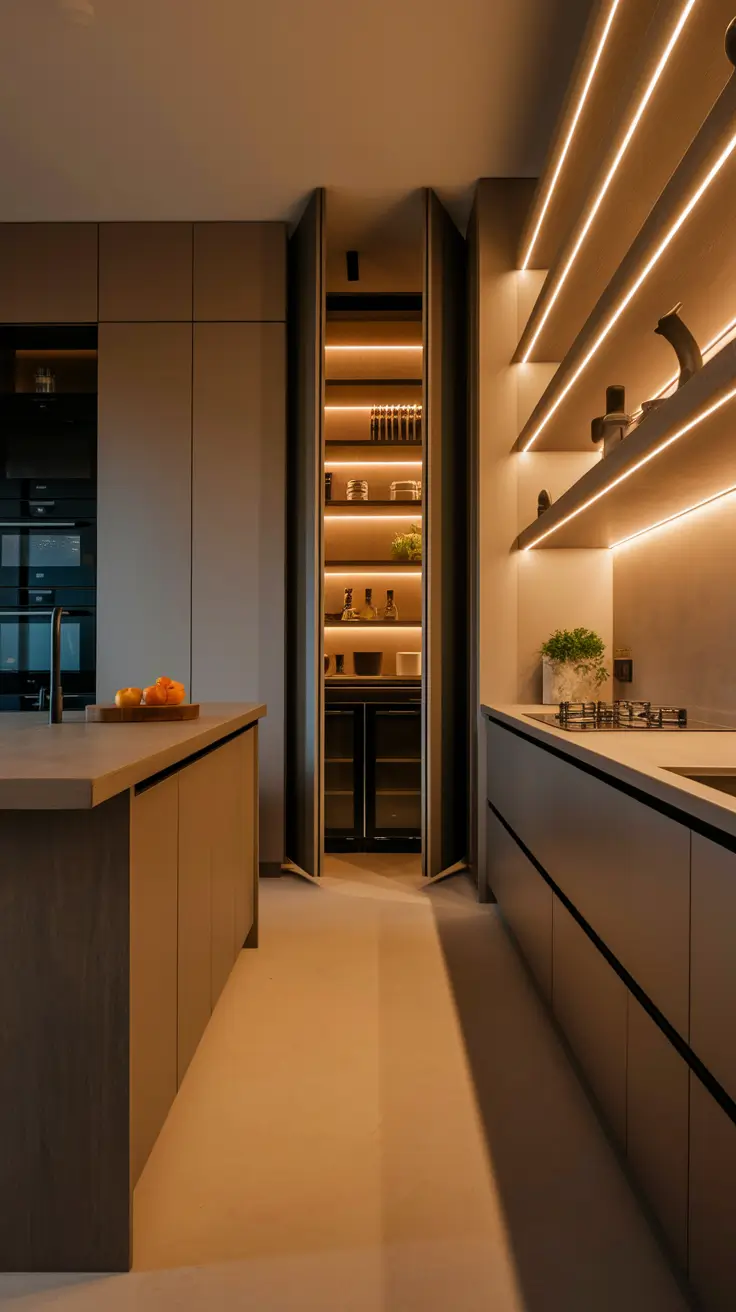
Let The Light In: Hidden Pantry Walk-In With A Window
Adding a window into a hidden pantry walk-in design can unexpectedly add warmth and life to the area. Although pantries are usually built without windows, I’ve found that adding even small windows makes the space feel much larger and more airy and inviting. This concept shines in miniature kitchens where bright lighting and small footprint are a must.
My recommendation is to use white oak or birch shelves that will increase the diffusion of light, with glass containers for dry staples and neutral flooring to maintain brightness. Using tall corner cabinets to frame the window and add woven baskets and linen curtains to them will make a cozy and stylish look. Including a light stone countertop under the window gives you a great working surface that you can easily use for meal prep or coffee sipping.
Based on my own experience, I have observed that adding windows to narrow walk-ins adds a lot to their look. Better Homes & Gardens has emphasized the importance of daylight in opening up kitchen storage spaces. I couldn’t agree more. Whenever possible, I make sure the window provides a view of outdoor plants, which adds to the peace and tranquility.
Adding a hanging rod for herbs or a plant shelf that is built in can help extend the design’s appeal and make it even more functional.
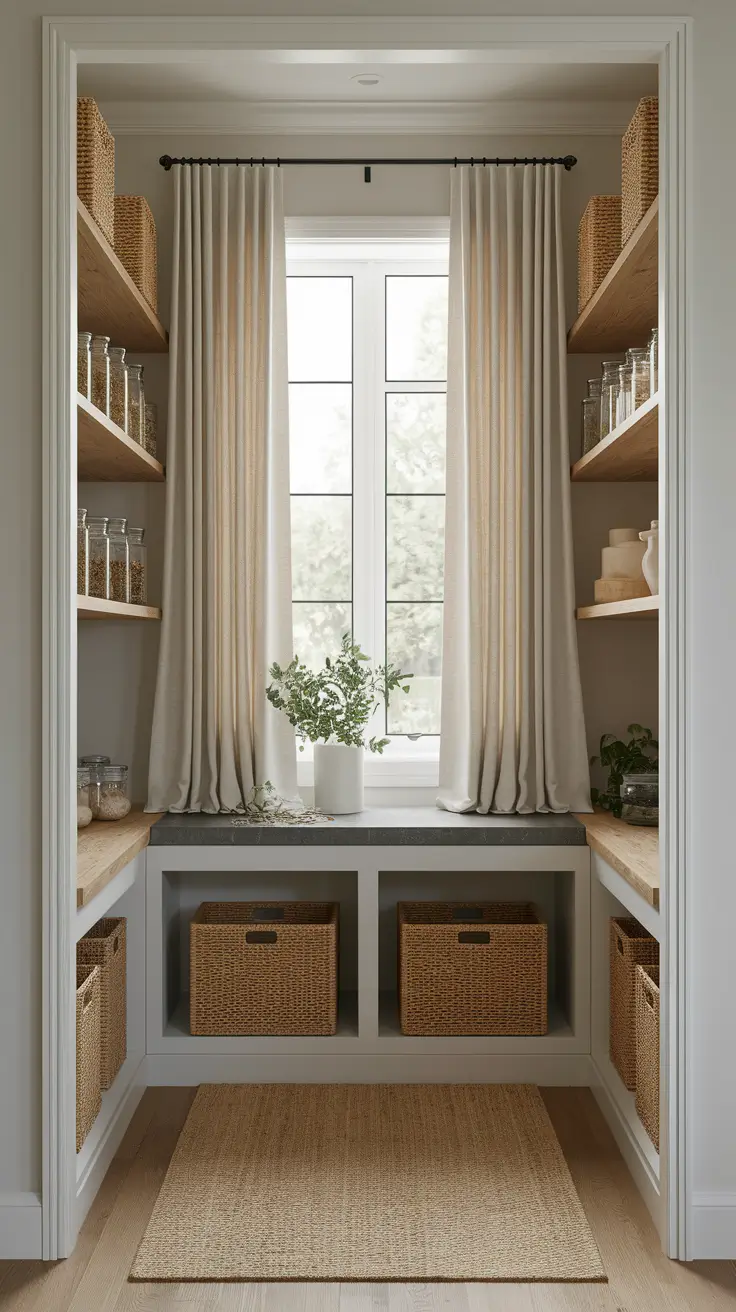
Combining Functionality And Style In Pantry Corners
Despite the reputation of corners as being hard to integrate, clever application of hidden pantry walk-in corner ideas can easily transform such awkward locations into chic storage alcoves. In numerous cases, I’ve transformed unused corners into hidden walk-in pantries which naturally complement the existing cabinets. A good layout design will help these additional functional elements blend in perfectly with the look and feel of your kitchen.
A custom L-shaped shelving unit is usually my go-to. I often use slim pull-out racks in small corners, deep storage units along the longer wall and a reflective or mirrored door to create the illusion of space. Incorporate small appliances, hidden pull-out bins, and soft-close cabinetry. Use LED strip lighting to brighten usually dark corners.
To my mind, these nooks are perfect for storing bulk goods and less regularly used tools. I always remind clients: Layout matters more than square footage. Small corners can be made very useful if an appropriate approach is taken. Elle Decor often points out that corners are wasted space in pantry designs.
What would enhance this even more? Install a swivel unit on corner shelves or purchase modular storage solutions that can be added to as your needs change.
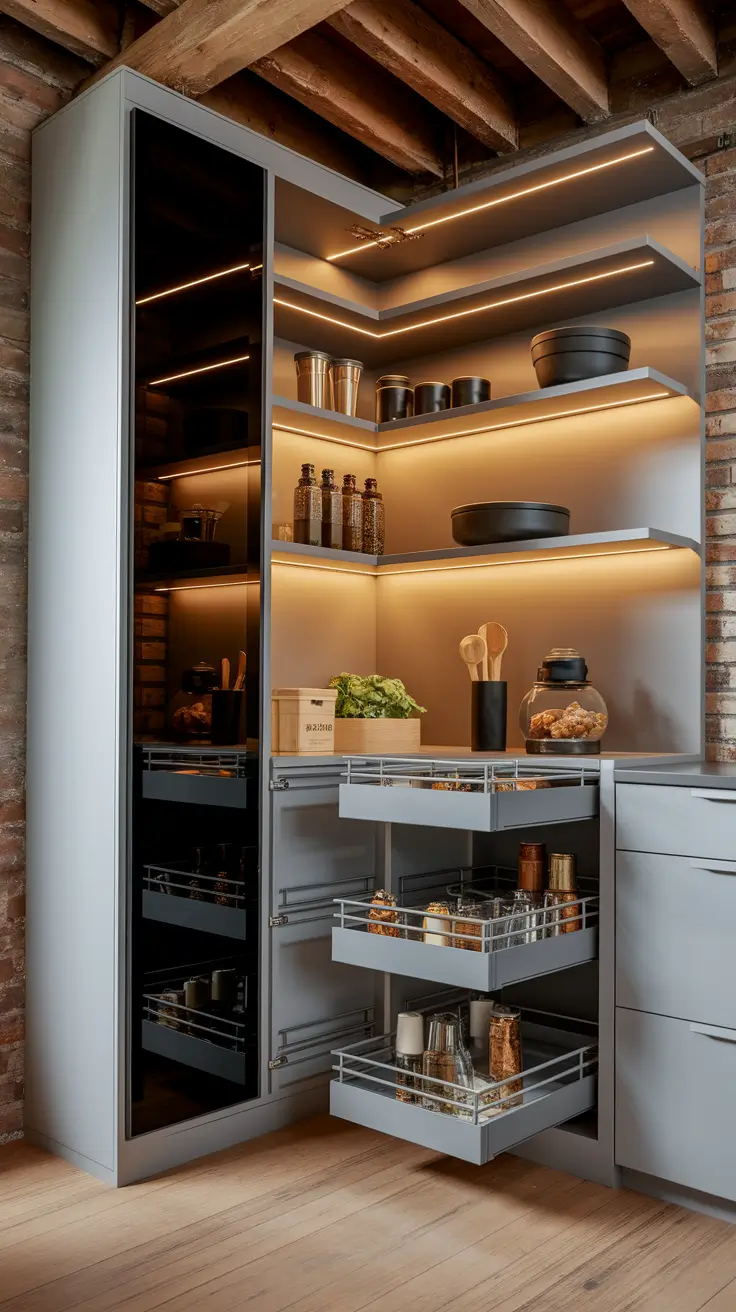
How to Create a Hidden Walk-In Pantry Inside Cabinet Doors: A Step-by-Step Guide
The idea of concealing a pantry walk-in behind cabinet doors provides a sleek solution in contemporary kitchens. Gallery and island designs are the most suitable for this method as it keeps symmetry and a clean look. You can use push-to-open doors with soft-close hinges and finishes that match. Inside, you can add industrial wire racks
One of the most common, design-oriented approaches to pantry walk-in kitchens that do not stand out is to put the pantry access behind tall cabinets. It hides your pantry nearly completely, perfect for those who want to go for a unified modern kitchen look. For kitchen designs such as galleries and islands, where symmetry is most important, I find this very effective.
When building this, choose doors that open with just a push and have soft-close hinges, preferably the same finish as your main cabinetry. Choose industrial wire racks, pull-out trays, and adjustable wooden shelves inside. Keep the flooring consistent with your kitchen for continuity. You can add matte or brushed gold handles to give the hidden pantry some polish if you expose any hardware.
I used this trick recently for a project in San Diego, and the client was very excited. House Beautiful says that coordinating the pantry entry with the cabinetry layout makes a cohesive and smoother look in contemporary kitchen areas.
To this, I could add a hidden sink in the pantry for a convenient fruit and vegetable preparation or fit it with a motion detector that would open doors without touching them.
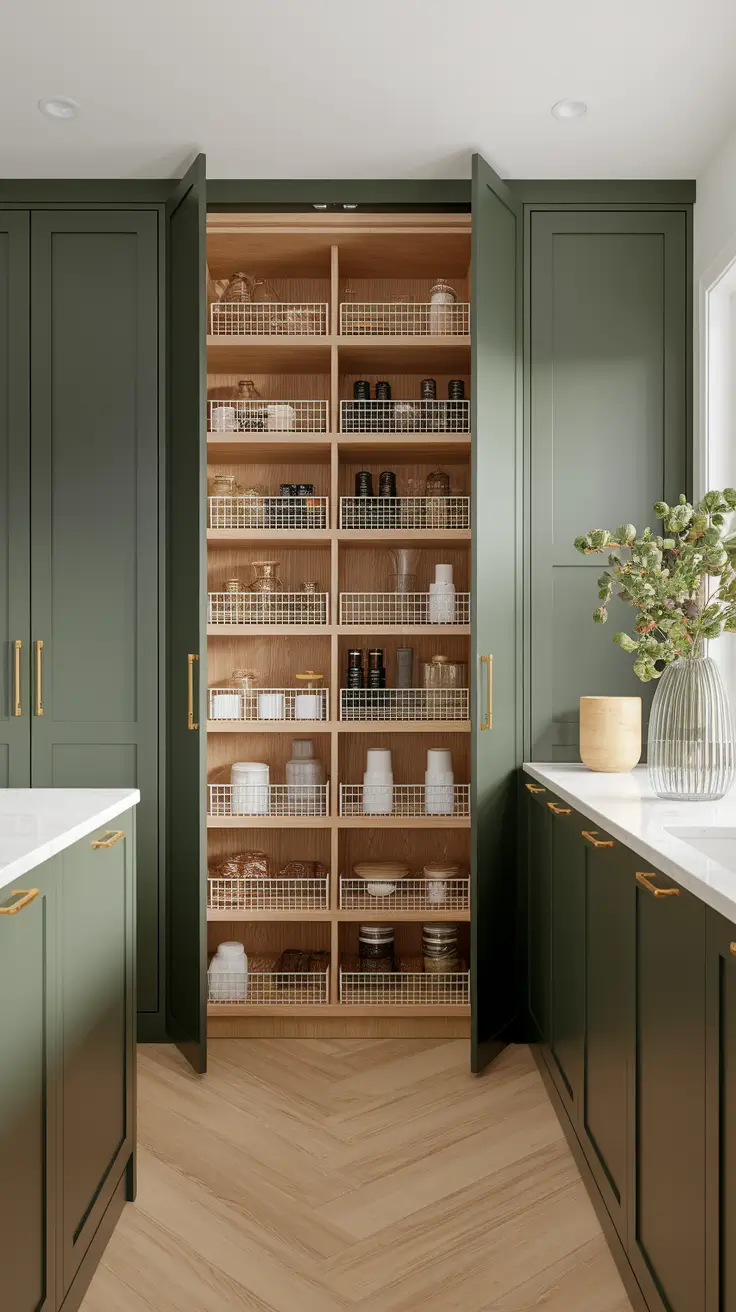
Hidden Pantry Walk-In Ideas For Open Concept Kitchens
An open concept kitchen hidden pantry walk in can keep a neat and organized look. My solution is usually to conceal these pantries behind feature walls or adjacent to corner modules, which can be placed next to load-bearing columns or clusters of cabinets. Our goal is to keep the space open but add practical and hidden storage.
From the design perspective, I recommend installing a frameless hidden door, installing internal vertical drawers, selecting open wood shelving, and ensuring there is enough internal lighting. If the pantry is near a living or dining area, installing sound-absorbing panels or a barn-style door with track lighting would be an excellent idea. The style of your pantry should match your kitchen’s with complementary colors, countertops and floor.
Many homeowners I’ve worked with are very pleased with the surprising secret storage space that comes out of this approach. Domino Magazine pointed out the way the concept effortlessly combines a minimal look with space-saving features. It’s a balance of aesthetics and utility I find extremely rewarding to design.
Another method of improving this arrangement is to include an appliance garage or separate storage for large countertop items you want to conceal but can easily access.
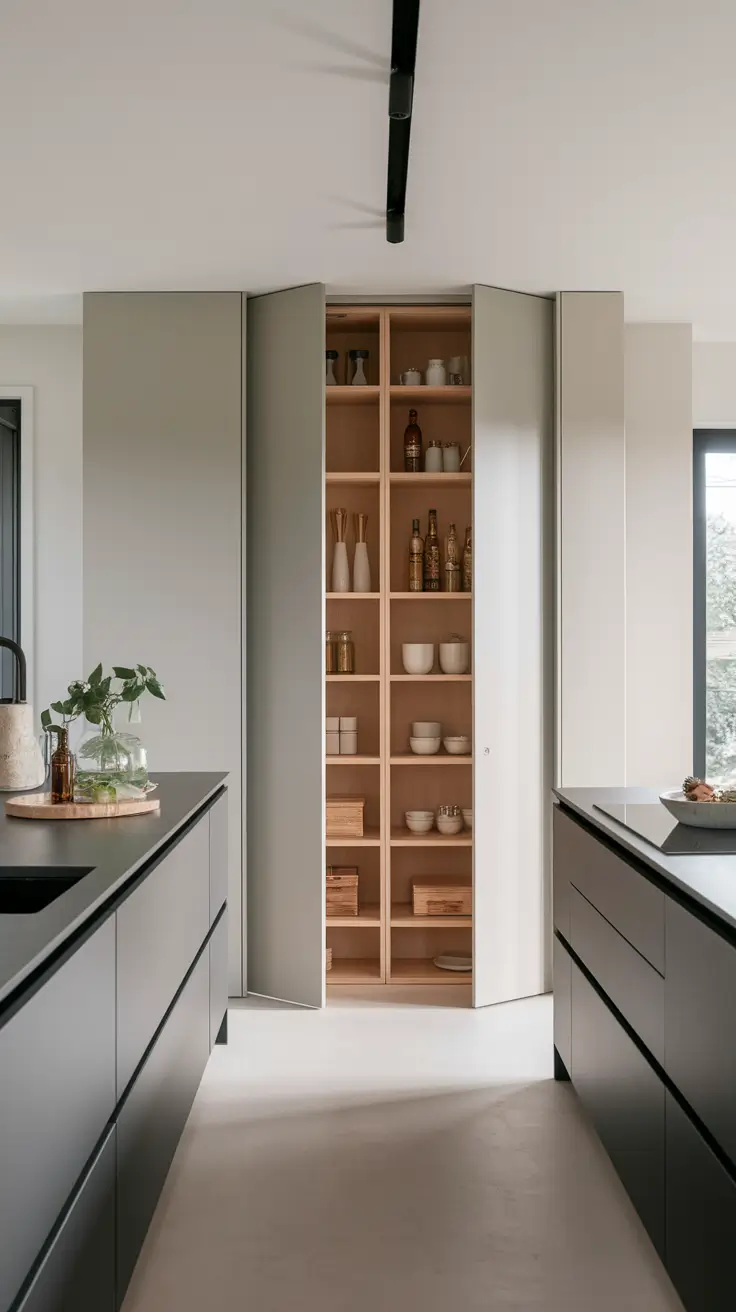
Rustic Meets Modern In Walk-In Hidden Pantries
A layered and timeless look is achieved when building a hidden pantry walk in that blends rustic elements with modern lines. My method of adding contrast includes the use of shiplap walls, the introduction of reclaimed wooden beams, and the addition of industrial glass doors. When these two design elements are combined, it is easy to design welcoming and organized farmhouse and transitional interiors.
Installing matte black or iron handles, a deep farmhouse sink, floating oak shelves, and vintage lighting will help you get this look. Place a wine rack in the most suitable place and use framed chalkboard labels for cabinet fronts. The flooring selections frequently feature raw-stained oak or distressed tile to add more texture to the area. Choose a modern pull handle that will match the rustic elements.
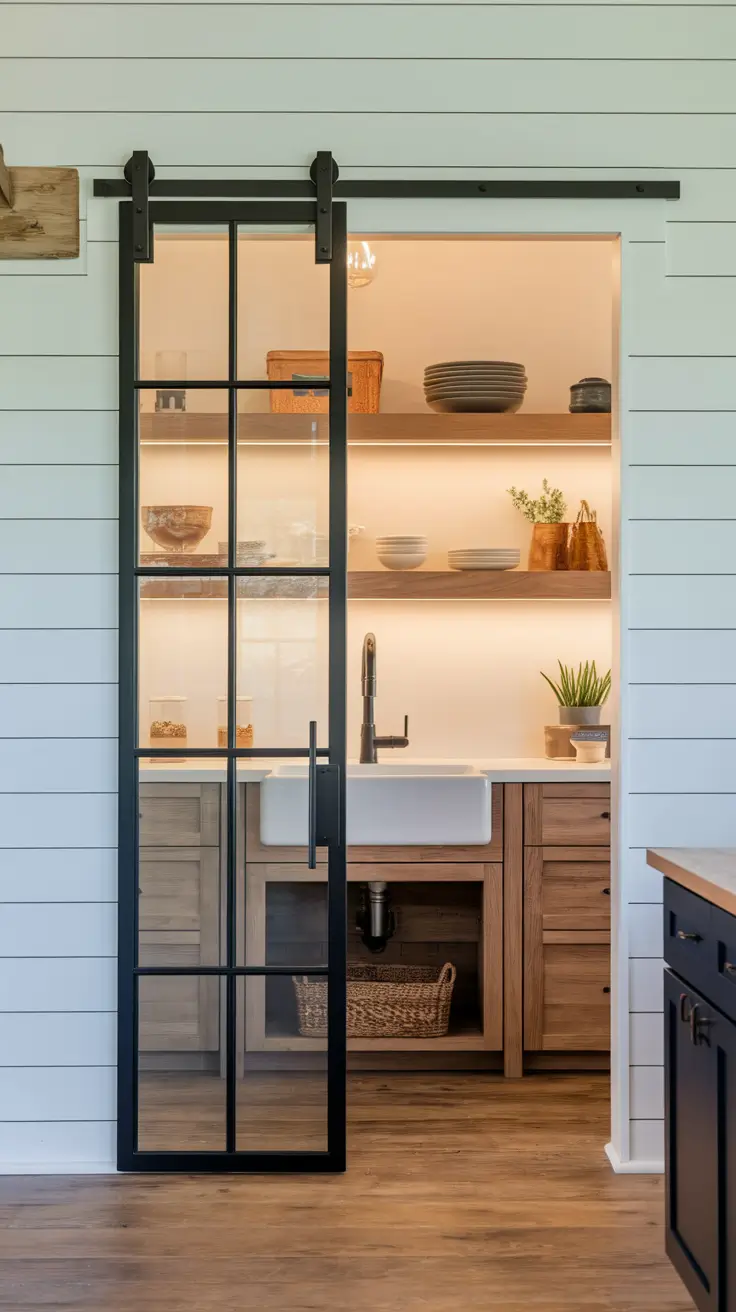
I just finished a project in Denver area that demonstrated this combination and impressed visitors on the home tour. HGTV explains that the use of different design eras creates more emotional connection and visual appeal – something I completely support.
It’s easy to turn the room into a multipurpose command center for hanging out and preparing meals with a comfy seating nook or handy prep table.
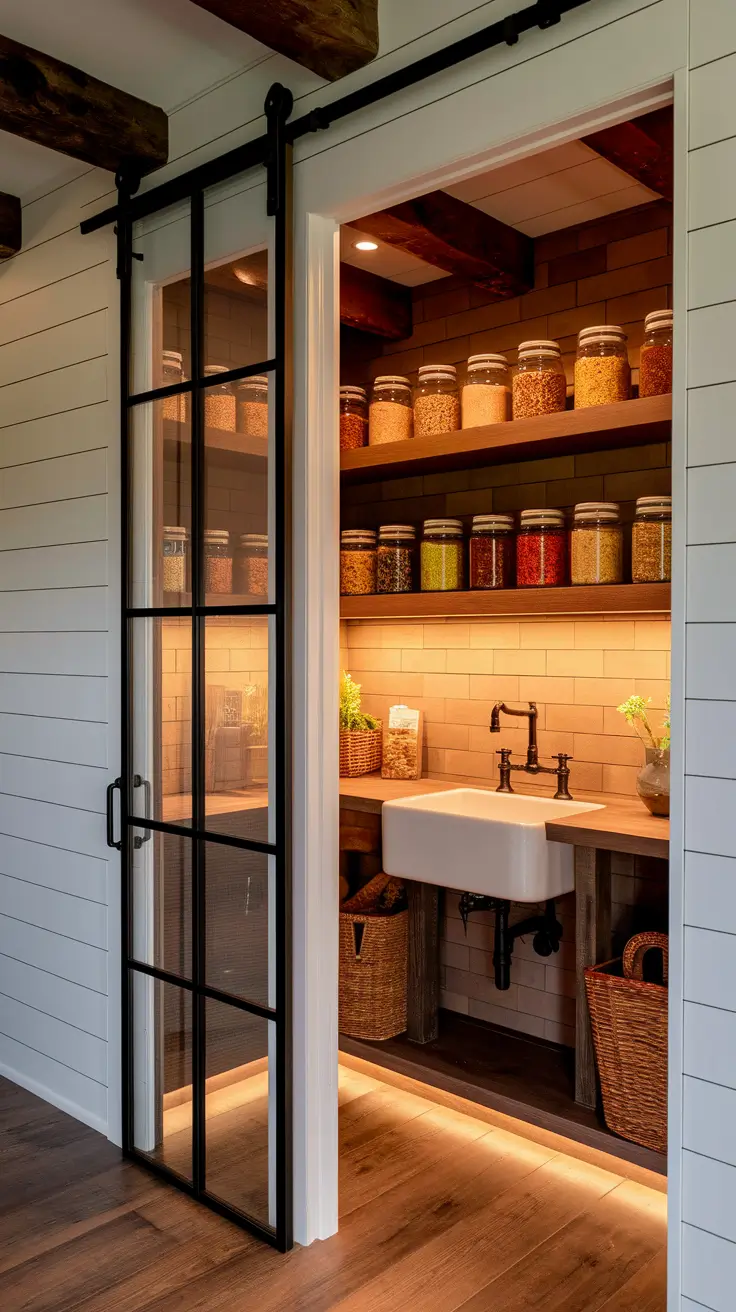
Creative Storage Solutions Inside Hidden Walk-In Pantries
When designing a hidden pantry walk in, the real objective is not to hide shelves, but to use efficient storage techniques. I’ve learned that maximizing vertical space is key. Using full-height shelving, labeled containers, pull-out baskets, and modular draw
My designs frequently include lazy Susans built in, trays that pull out for large appliances, and tiered racks for spices. The installation of open bins for onions, potatoes and root vegetables becomes a useful addition. Storing dry goods in glass jars on open, labeled shelves improves functionality and the appearance of the kitchen. Insertion of LED strips under every shelf edge guarantees visibility of contents.
Clients often thank for such improvements, mentioning that they transform their cooking habits. Modularity and clear labeling are important at Martha Stewart Living for pantry design; I follow their advice as much as possible.
Add magnetic knife strips, use a chalkboard wall for grocery lists or a sliding library ladder for larger spaces to spruce up your pantry.
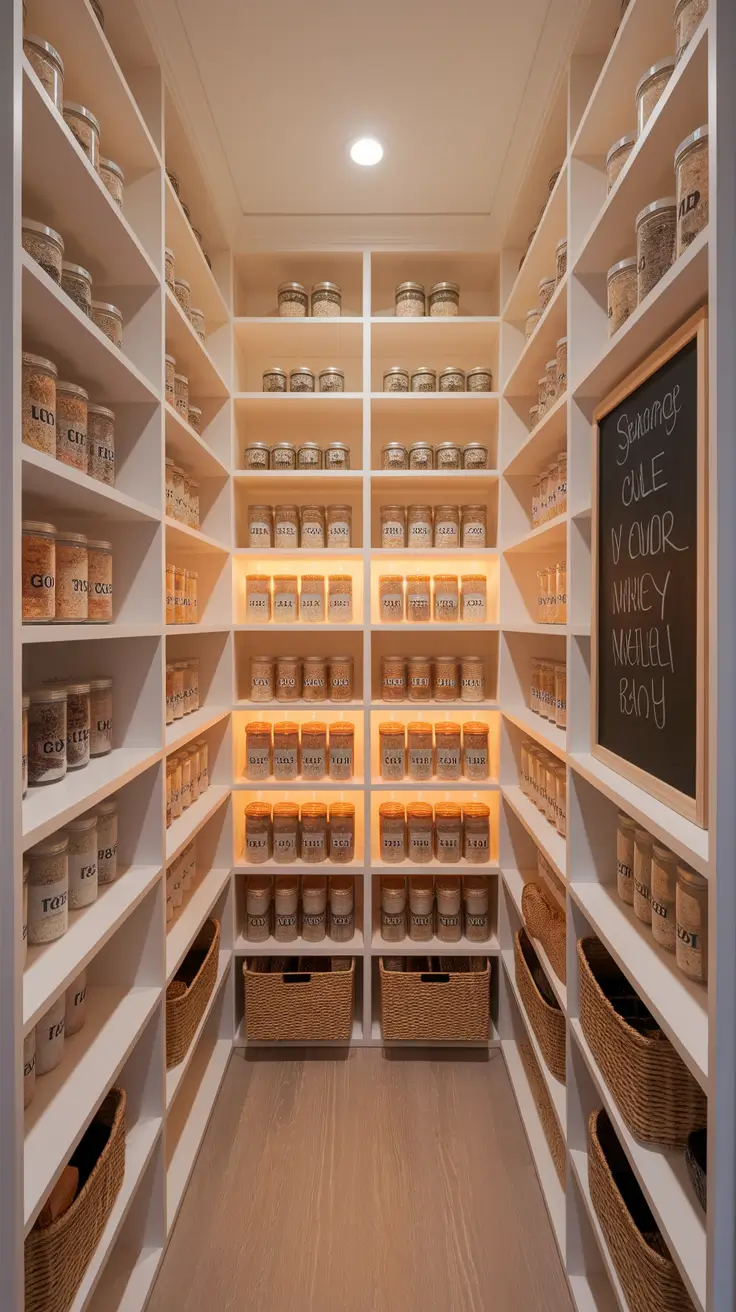
Organizing A Hidden Pantry Walk-In For Everyday Use
One of the key features of a hidden pantry walk in is to make it easy to use and effortlessly support your daily activities. In my experience, organization is what makes an interesting pantry into a useful one. To make the best use of your daily activities, pay attention to the creation of an open and organized layout. It’s not enough for your pantry to be hidden—it should also be intuitive and streamline your cooking or cleaning process.
Start with open shelving arranged by daily-use categories: breakfast items, snacks, baking essentials, and canned goods. Use bins with visible labels for fruits and vegetables, separate baskets for towels, and drawers for sundry utensils and linens. Begin a conversation by sharing your thoughts! For families, consider a pull-out school snack station. Install a vertical file holder onto the pantry for storing grocery lists, coupons and any recipes that have been collected. Use soft-closing cabinetry to fit in bigger gadgets such as a food processor or blender which do not feature among your countertop appliances.
I like clear jars for grains and cereals because they not only make organization easier, but they also add to a nice display in the pantry. According to The Spruce, transparent storage alternatives simplify stock management and reduce the likelihood of food waste. Having weekday meals organized well in my kitchen helps me to get hours back every month.
An added motion sensor light strip would make nighttime snacking easier, and a rotating pantry caddy makes it easier to store tall products such as oils and vinegars.
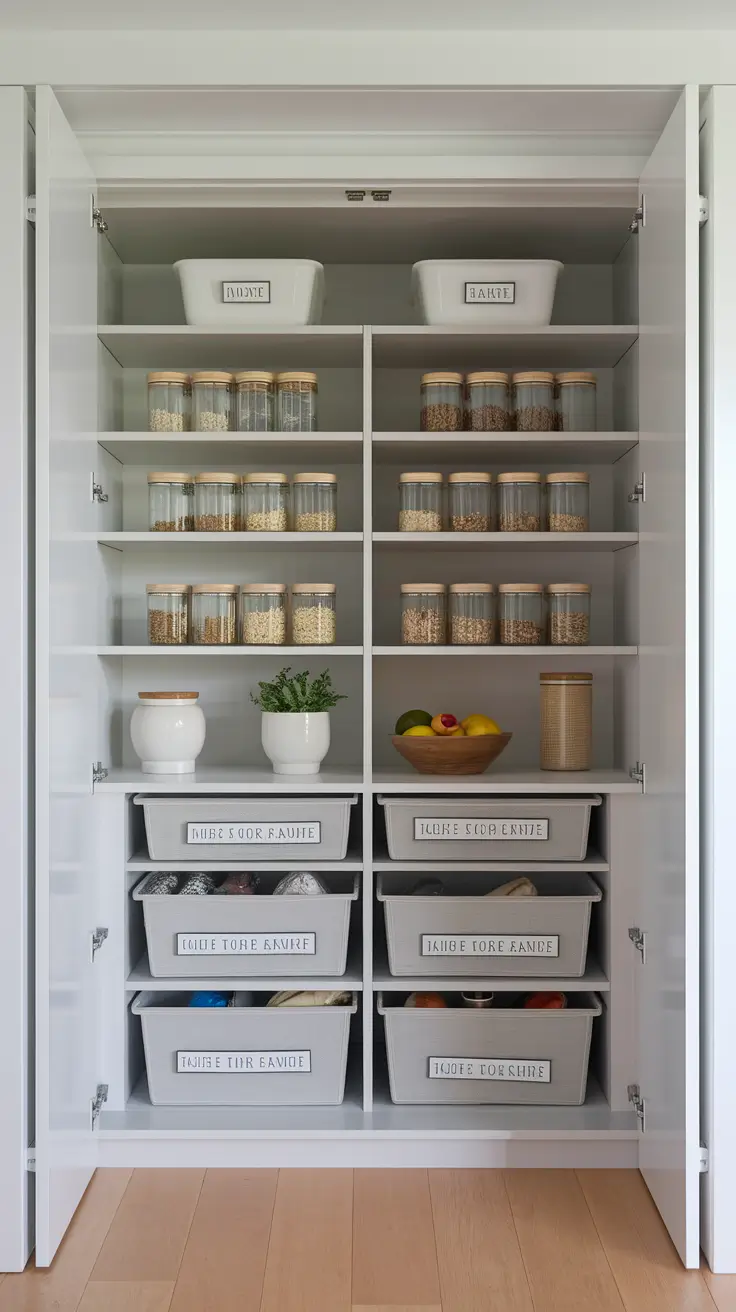
Save Pin
